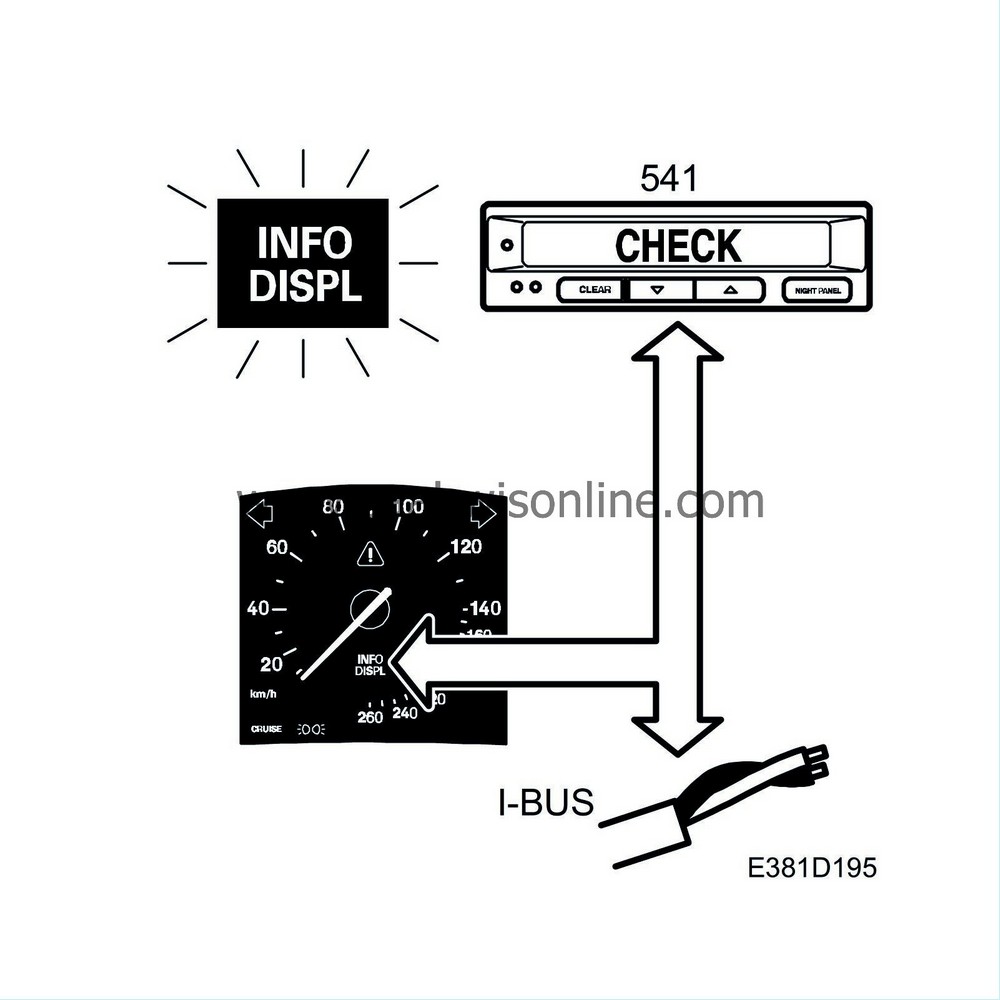Warning and indicator lamps
| Warning and indicator lamps |
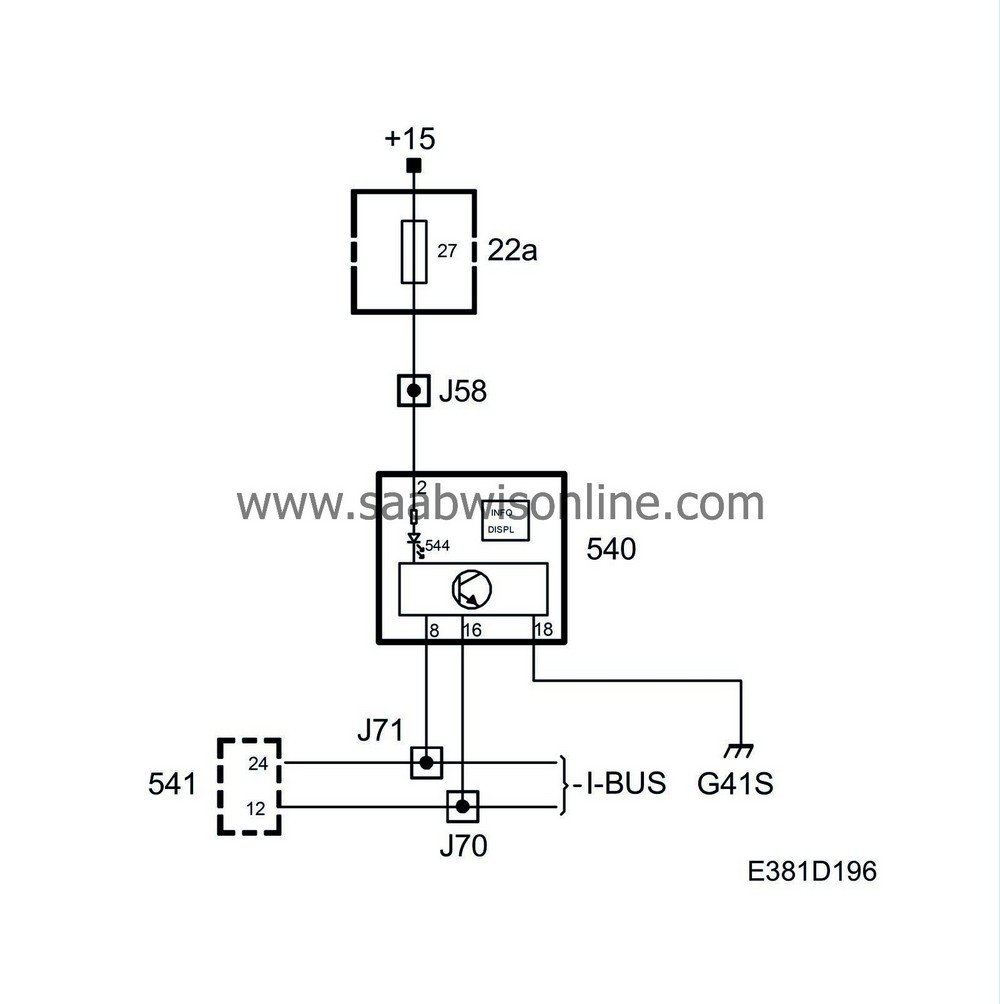
The INFO DISPL lamp is lit when a message is shown in SID. The lamp is supplied with +15 voltage in the main instrument and grounded internally in the main instrument unit. SID continuously sends the bus information INFO DISPL, unit ON/OFF.
On receiving INFO DISPL ON, the control module grounds the output for the lamp which then lights up.
The main instrument unit lights this lamp for 3 seconds when the ignition is switched on.
Diagnostics
The function has no diagnostics.| Central warning lamp |

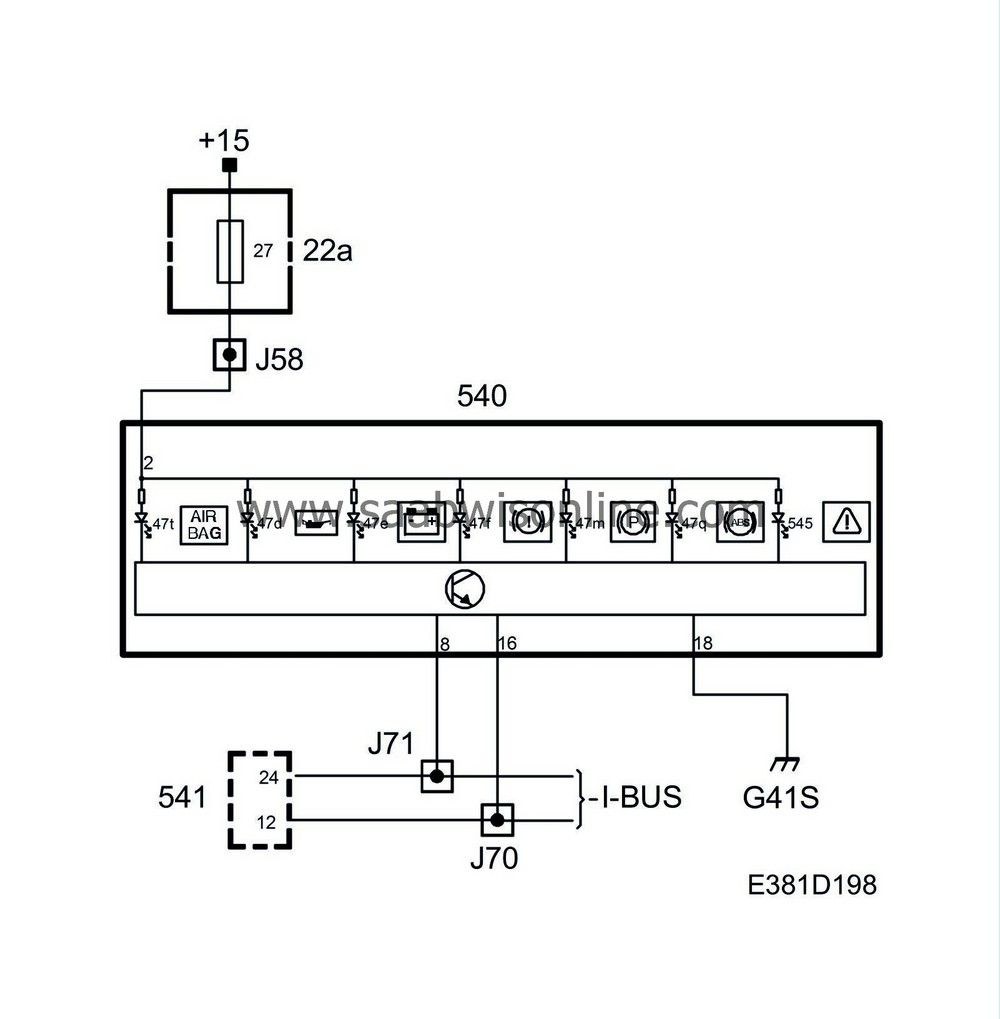
The central warning lamp lights up when a fault occurs in a system relating to the car's safety.
The lamp is supplied with +15 voltage in the main instrument unit and grounded internally in the main instrument when any of the following warning or indicator lamps are lit:
| • |
AIRBAG lamp
|
|
| • |
Oil pressure lamp
|
|
| • |
Charging lamp
|
|
| • |
Brake fluid warning lamp
|
|
| • |
Handbrake lamp
|
|
| • |
ABS warning lamp
|
|
The handbrake lamp lights the central warning lamp if the speed passes 5 km/h from a speed below 5 km/h.
The central warning lamp also lights up when:
| • |
Coolant temperature exceeds 129°C
|
|
At the same time as the central warning lamp is lit, the main instrument unit sends bus information to SID to activate an acoustic signal. This does not happen when the ignition is turned on as only the bulbs are being tested; the engine speed must be above 300 rpm for this request.
Diagnostics
The function has no diagnostics.| Oil pressure warning lamp |

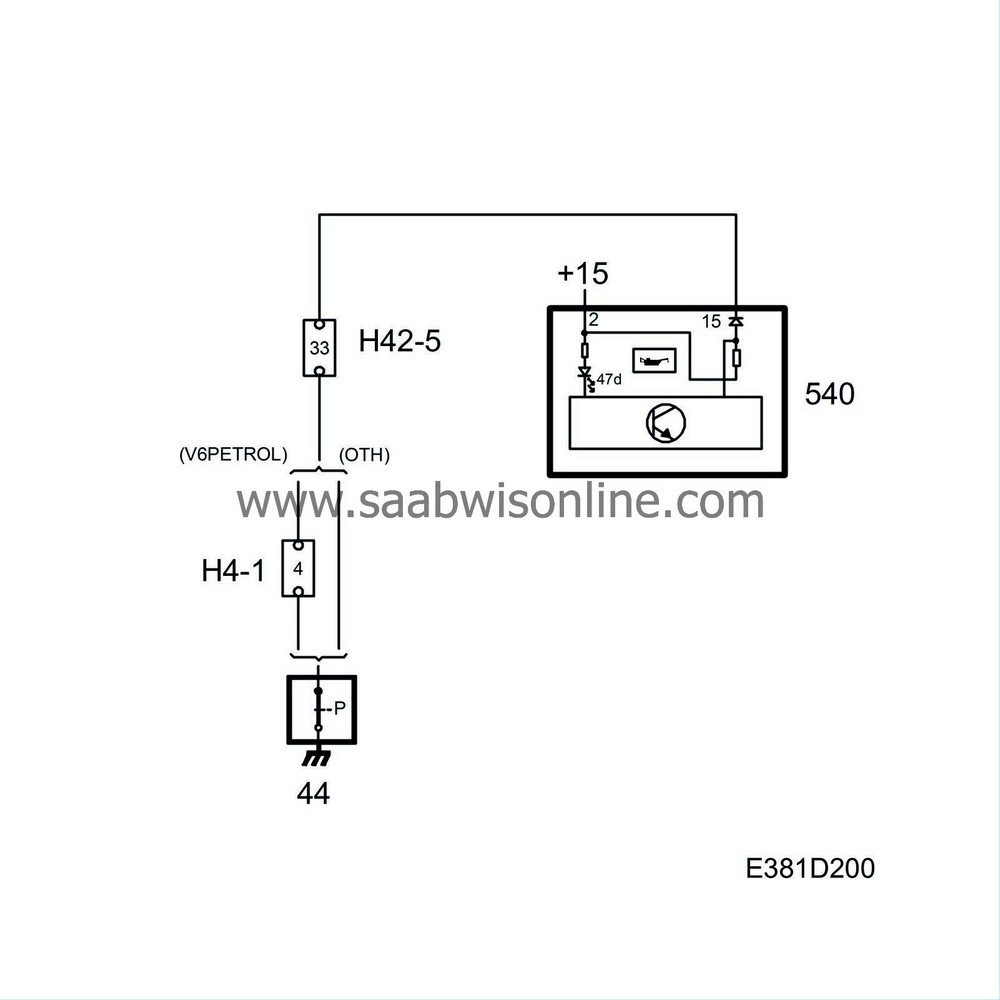
The oil pressure warning lamp is situated in the top RH corner of the instrument display. This lamp warns the driver when engine oil pressure is too low.
If the oil pressure falls below 0.3-0.5 bar, the oil pressure sensor makes contact, pin 15 in the main instrument unit is grounded and the control module turns on the lamp. At the same time, the central warning lamp is lit and at engine speeds above 300 rpm, MIU sends a request to SID to activate the acoustic signal.
Diagnostics
The function has no diagnostics.| Charge warning lamp |
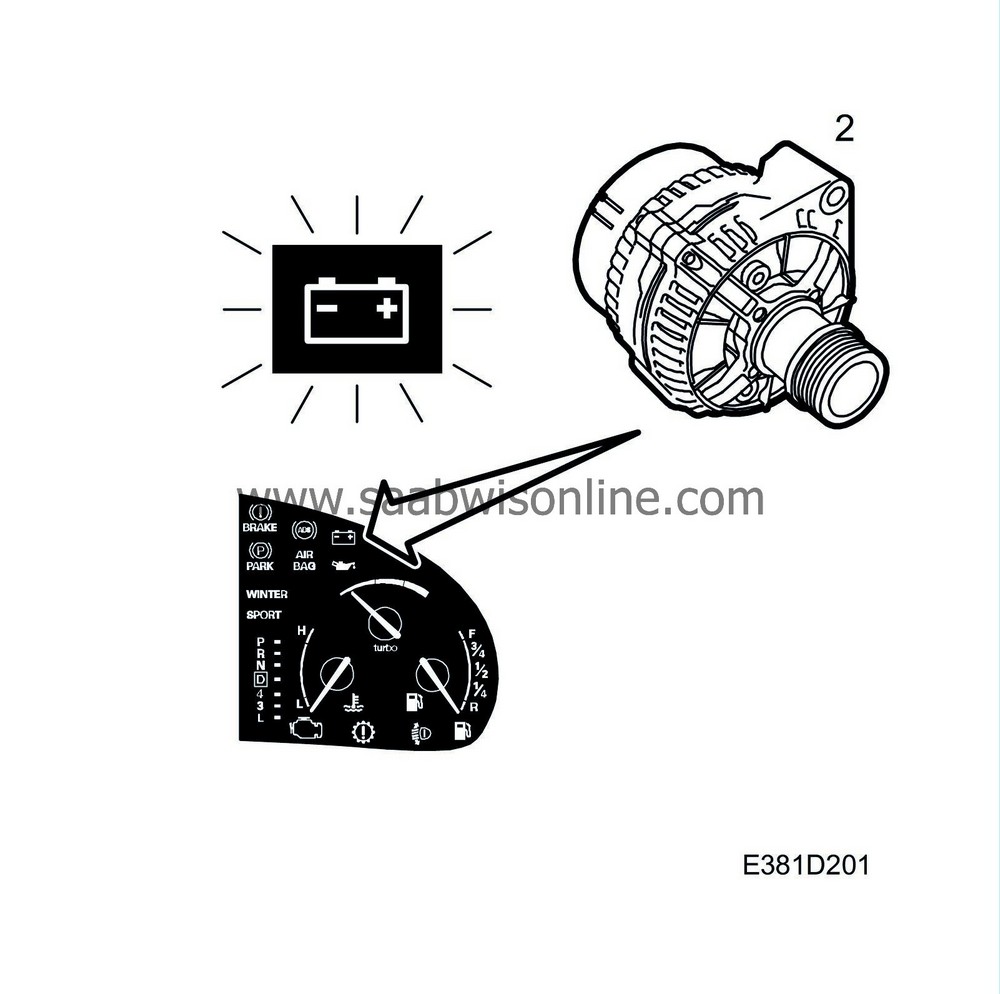
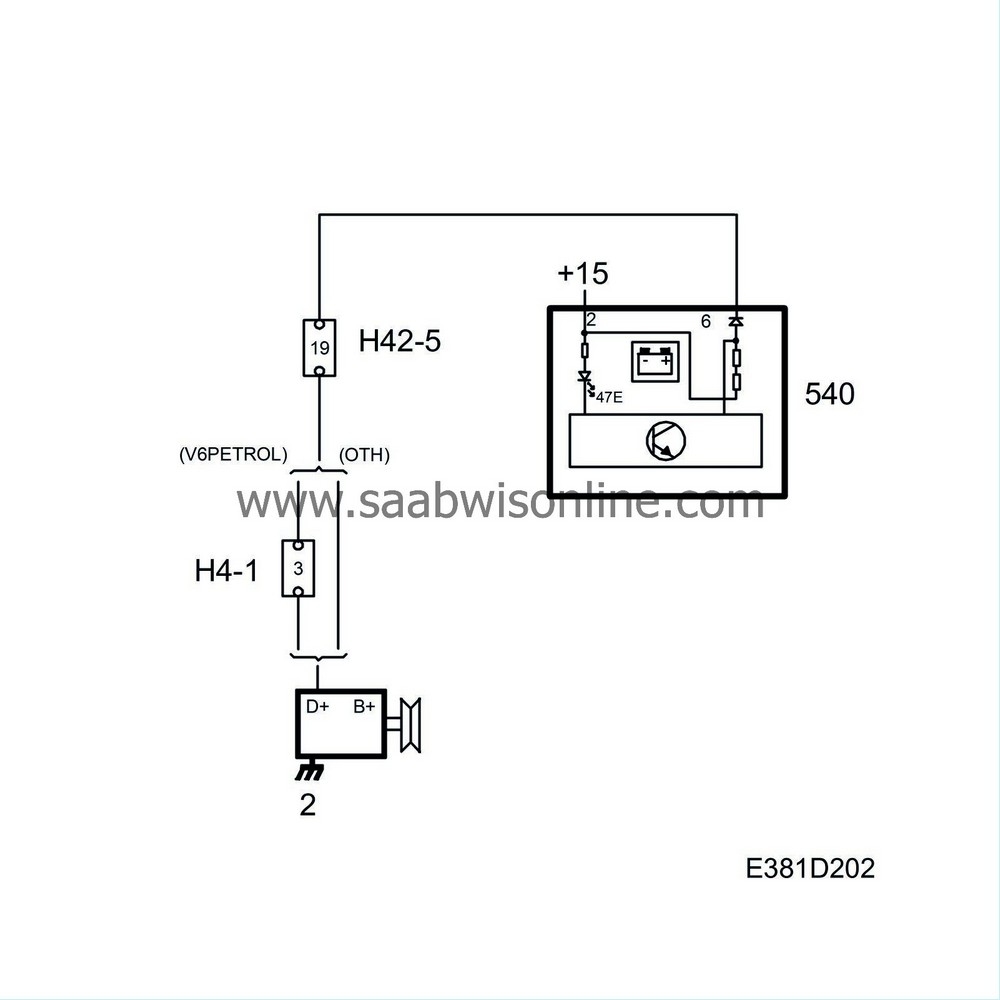
The charge warning lamp is situated in the top RH corner and informs the driver whether or not the generator is charging.
The lamp is supplied from the main instrument unit and grounded internally in the main instrument unit.
If the generator is not turning or not charging for any reason, pin 6 on the main instrument unit is grounded via the regulator from the generator field winding, whereupon the control module lights the lamp. At the same time the central warning lamp is lit and at engine speeds above 300 rpm, the MIU sends a request to SID to activate the acoustic signal.
When the generator is charging, D+ on the generator has the same voltage as B+ on the generator, which means that the input on the MIU is supplied with power B+ whereupon the control unit turns off the lamp.
Diagnostics
The function has no diagnostics.| Warning lamp, AIRBAG |
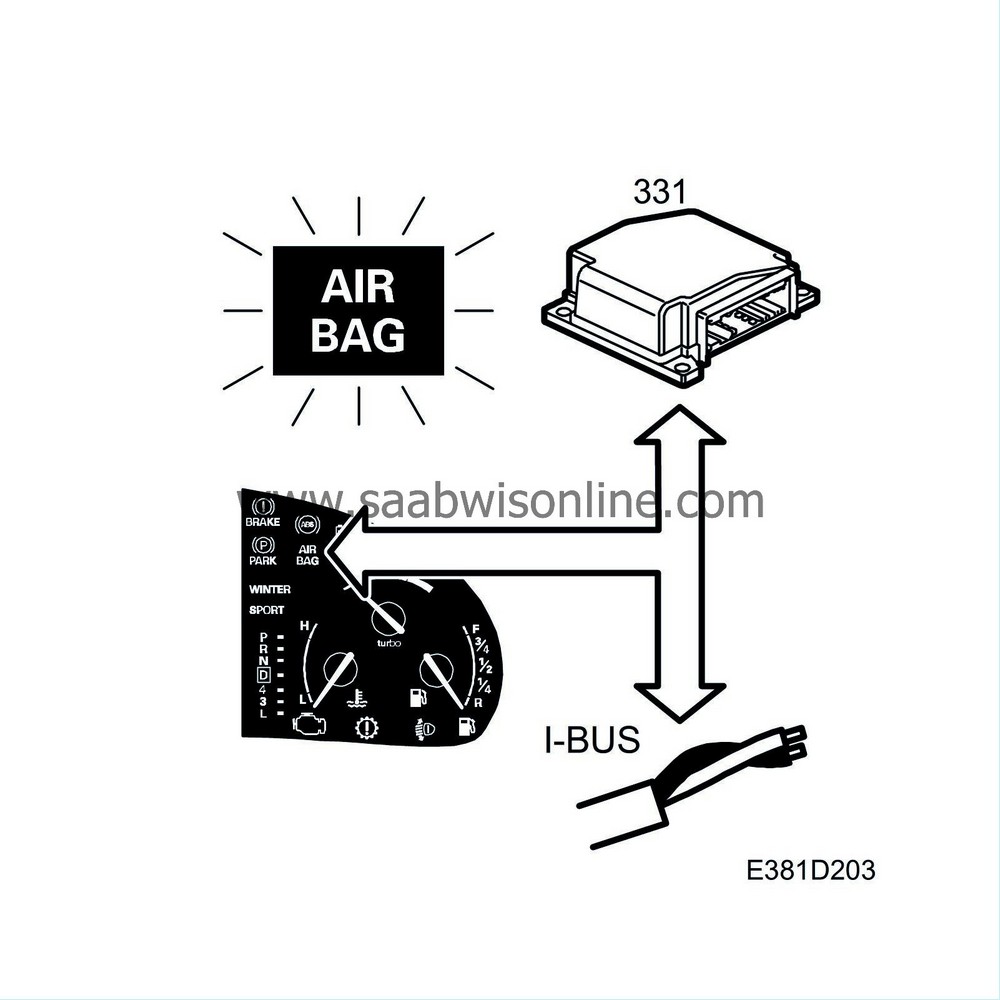
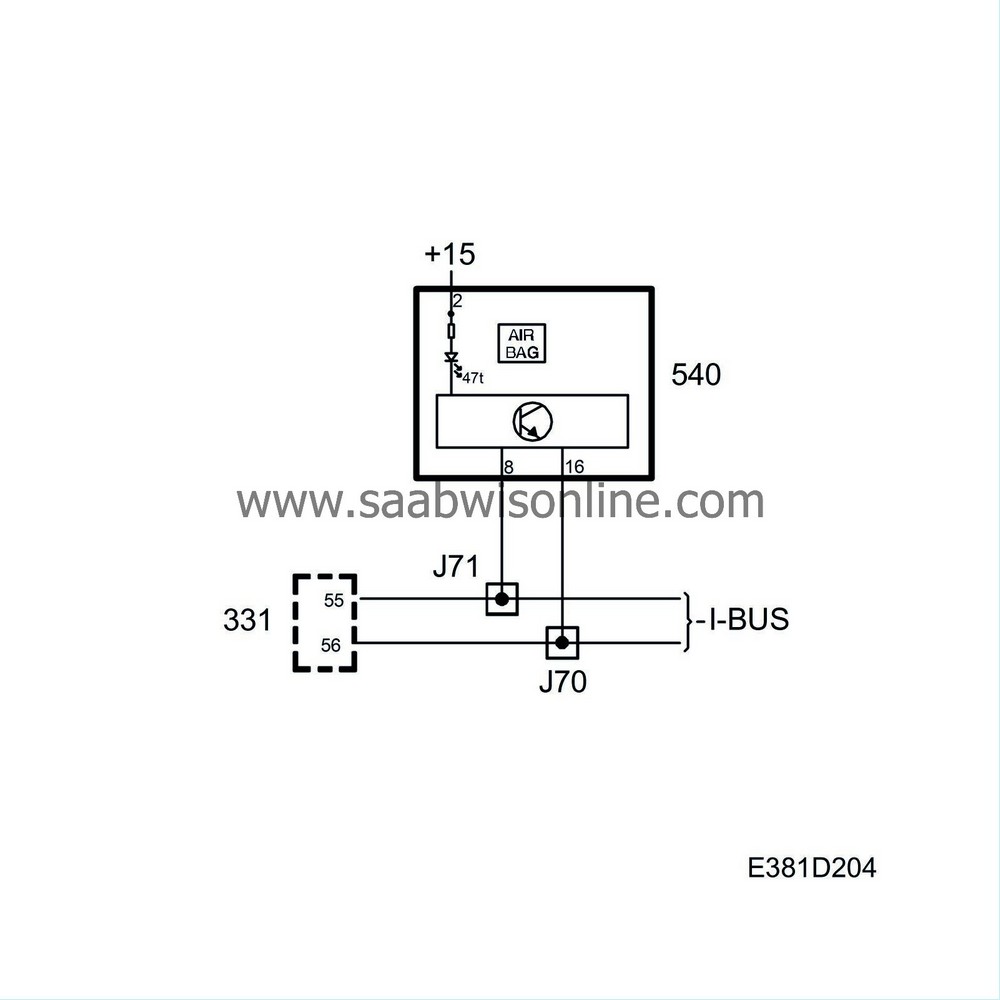
The airbag warning lamp is on the RH side of the main instrument unit.
A fault in the system is indicated by the airbag warning light coming on permanently.
On normal function, the SRS control module sends a message to the bus to turn off the airbag warning lamp. If this message is not sent, the MIU turns on the lamp. SRS can also in certain cases send the light message on the bus. This ensures the lamp is lit as quickly as possible.
The central warning lamp is lit as the same time as the airbag warning lamp and at engine speeds higher than 300 rpm, the MIU sends a request to SID to activate the acoustic signal.
When the ignition key is turned to the start or drive position, the airbag warning lamp comes on for 3-4 seconds before then going out if no trouble codes are stored.
If there are trouble codes stored, the lamp will light for 3-4 seconds, then go out for half a second, and then come on permanently until the ignition is turned off or the trouble code is cleared.
If an airbag or belt tensioner has tripped, the airbag warning light is lit constantly.
Diagnostics
The function has no diagnostics.| Warning lamp, brake fluid level |
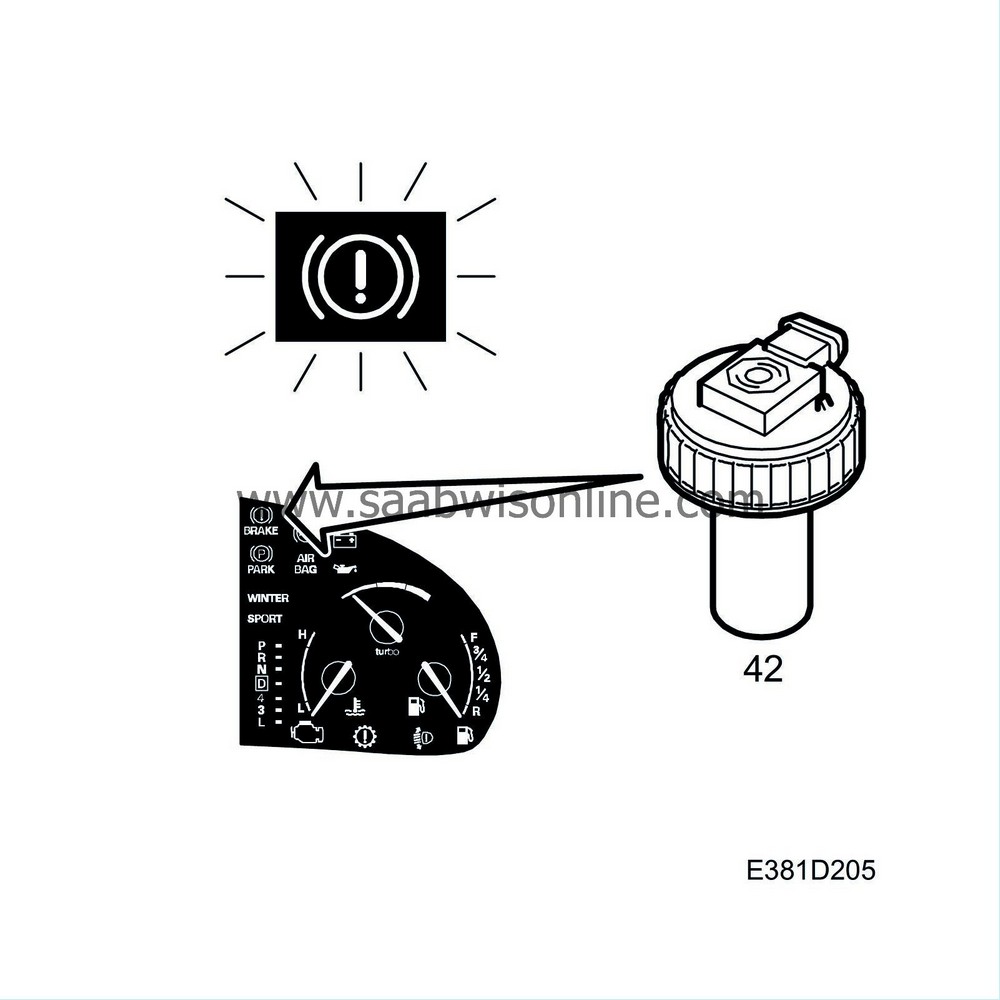
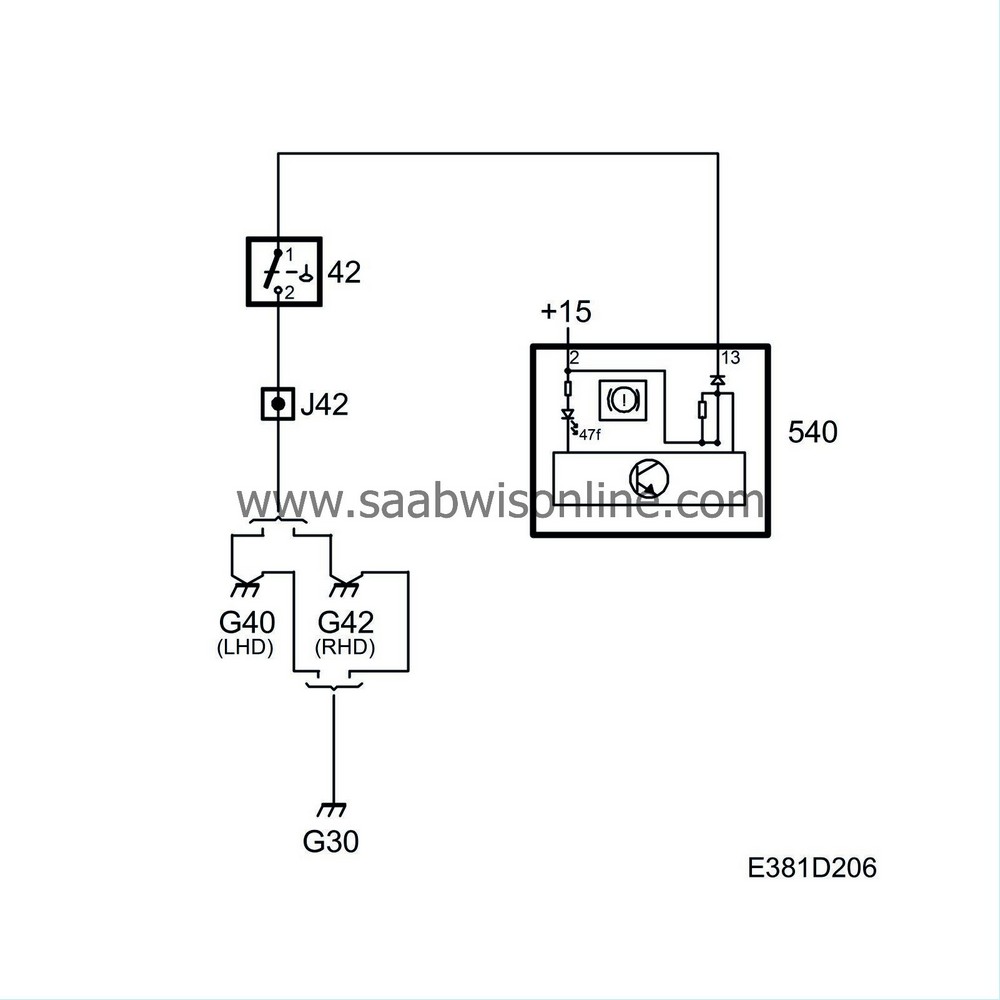
The brake fluid warning lamp warns the driver if the level of fluid in the reservoir is too low. The lamp will also go on if there is a fault in the ABS system.
If the brake fluid level is too low, the level switch closes and pin 13 in the main instrument unit is grounded, whereupon the control module lights the lamp. At the same time, the central warning lamp is lit and at engine speeds above 300 rpm, MIU sends a request to SID to activate the acoustic signal.
The main instrument unit lights the brake fluid level warning lamp for 3 seconds when the ignition is turned on.
Diagnostics
The function has no diagnostics.| Warning lamp, handbrake |
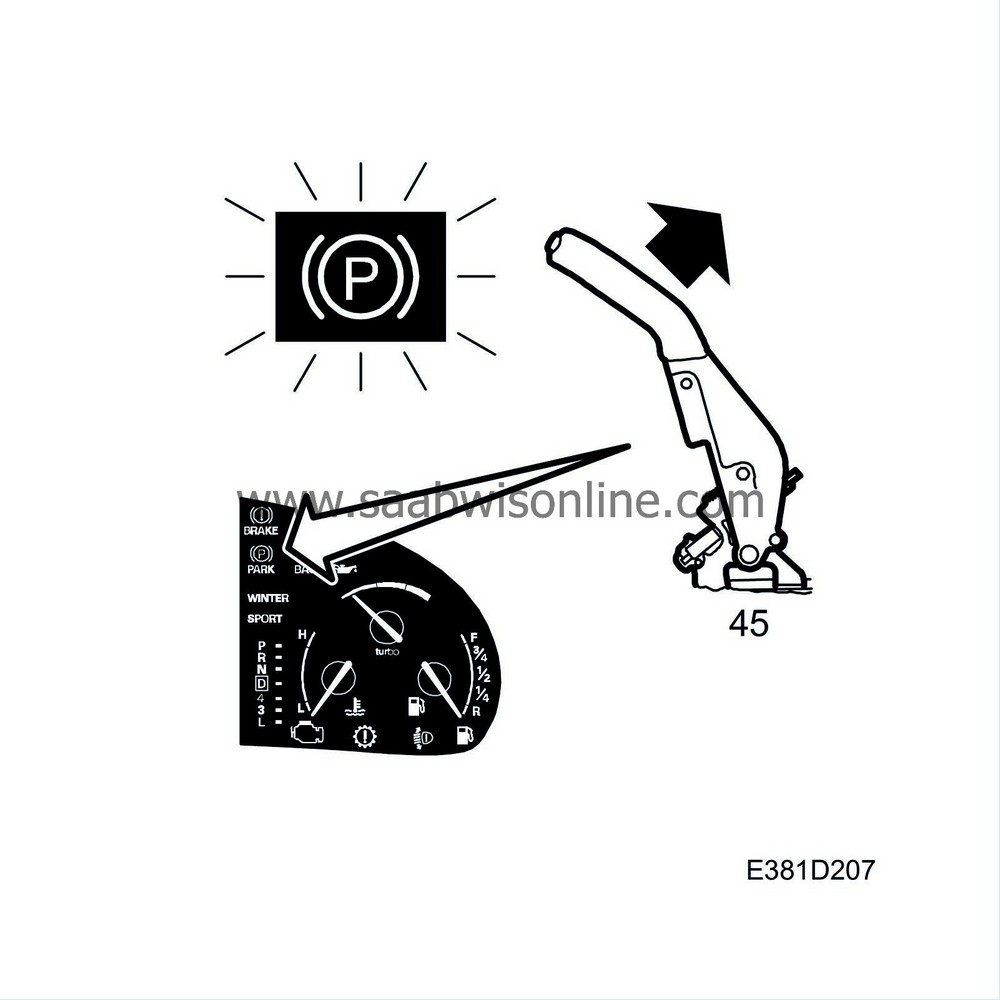
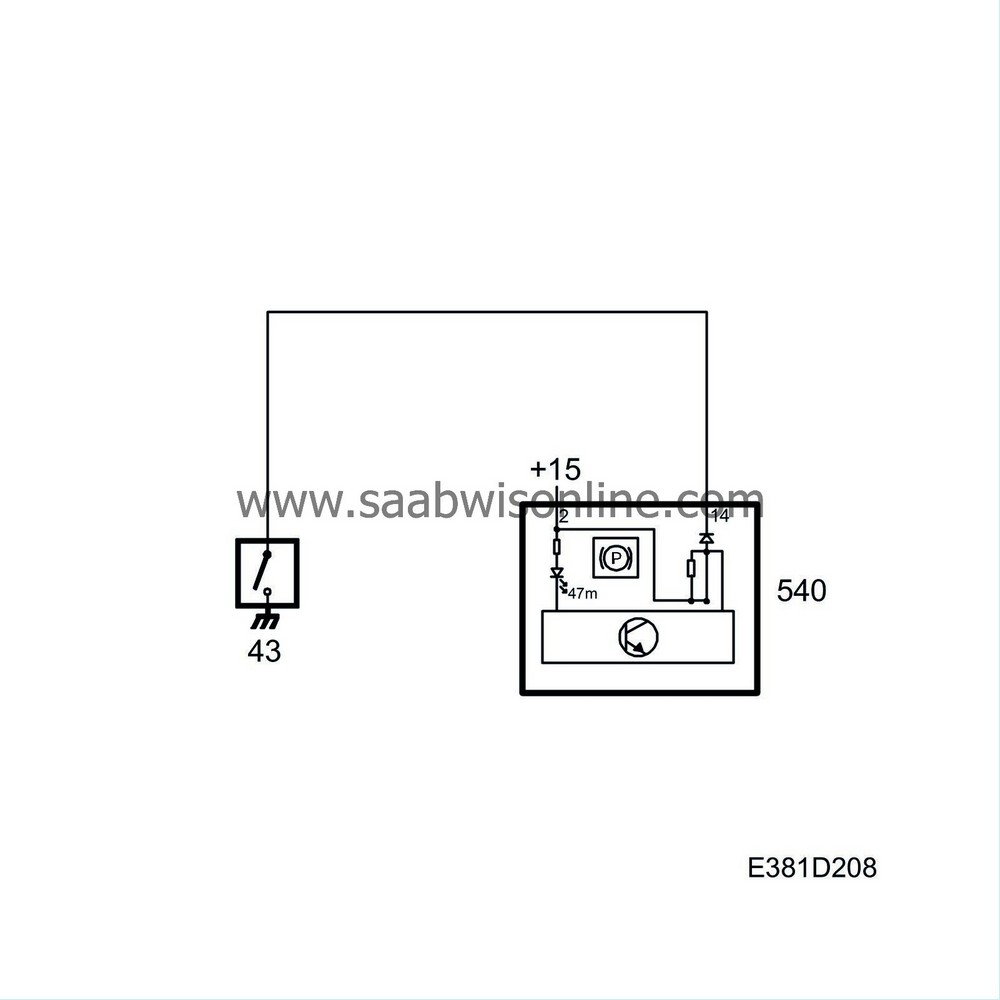
The handbrake warning lamp is situated on the RH side of the main instrument unit and informs the driver if the handbrake is applied.
If the oil pressure falls below 0.3-0.5 bar, the oil pressure sensor makes contact, pin 15 in the main instrument unit is grounded and the control module turns on the lamp.
When the handbrake is applied, pin 14 on MIU is grounded by the contact on the brake lever handbrake lever, which means that the control module turns on the lamp.
If the speed exceeds 5 km/h from a speed lower than 5 km/h when the handbrake is applied, the central warning lamp comes on and MIU sends a request to SID to activate the acoustic signal.
Diagnostics
The function has no diagnostics.| TCS/ESP indicator lamp |
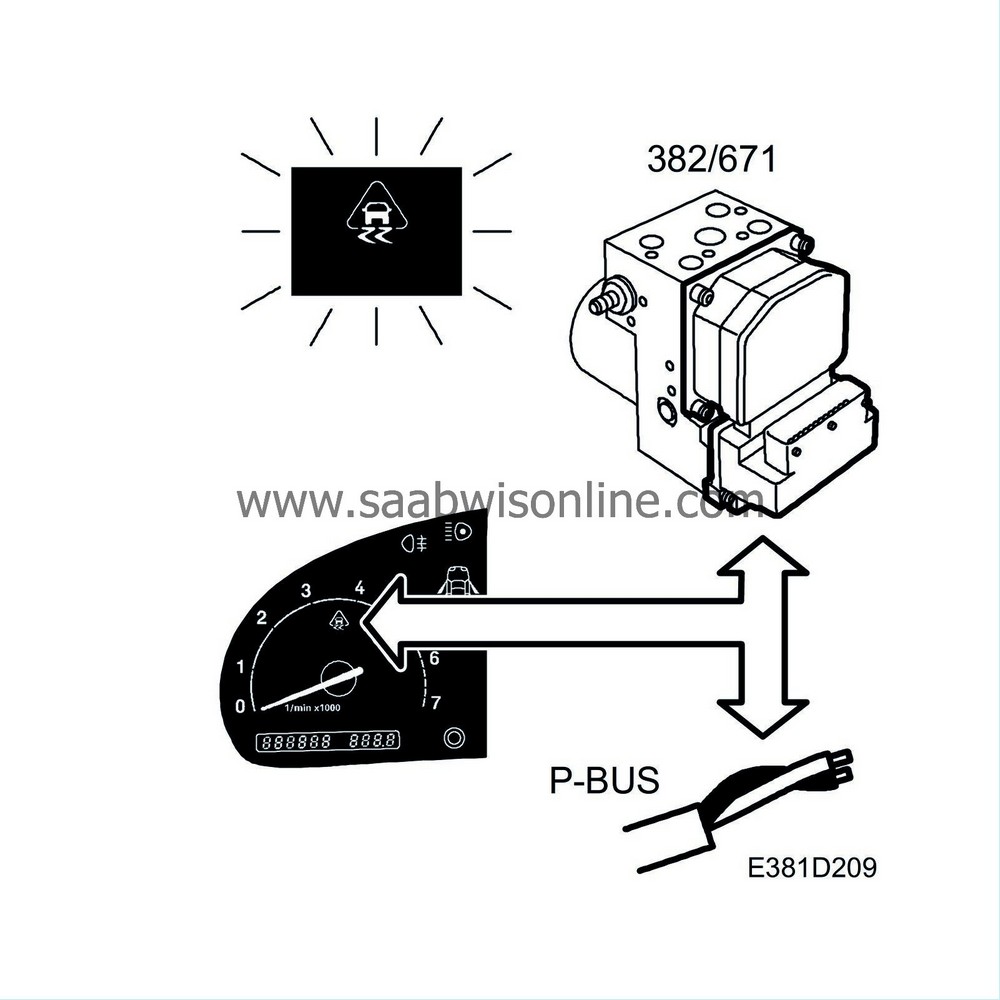
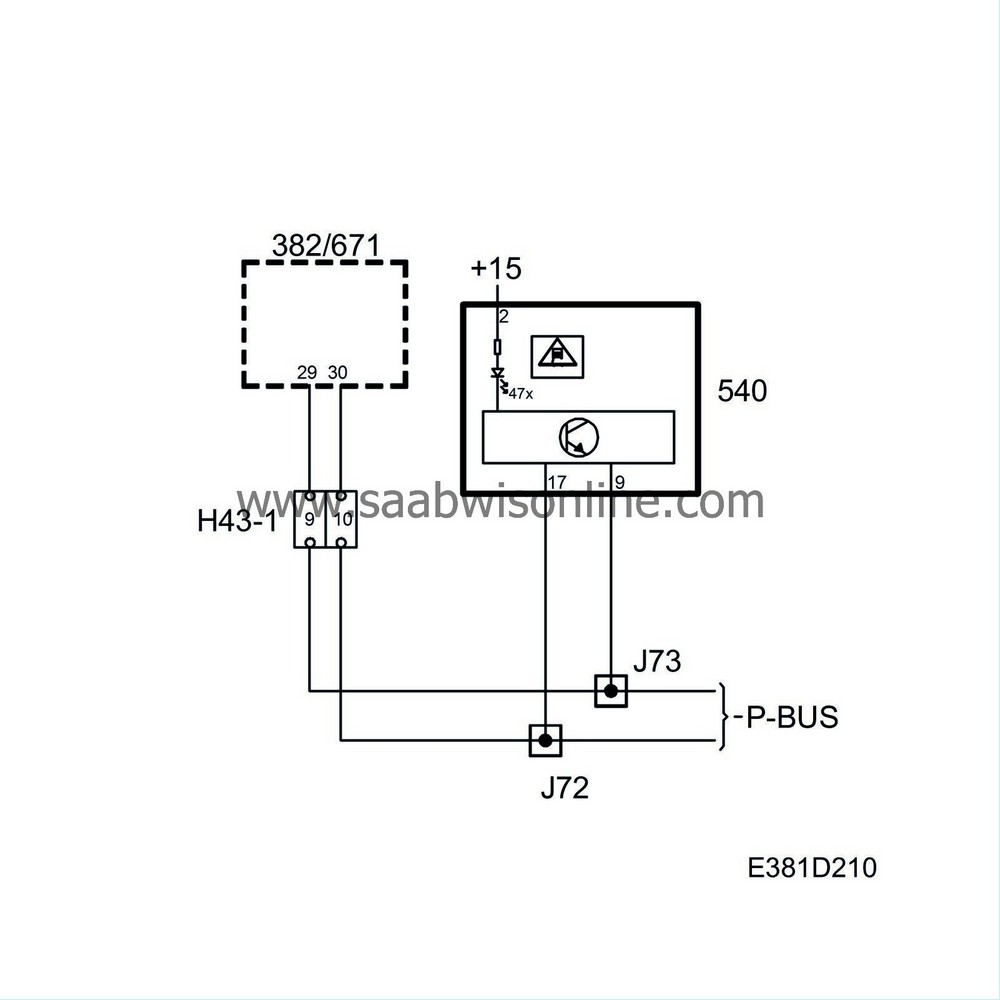
The TCS/ESP function lamp is on the LH side of the main instrument (in the tachometer). The lamp comes on when the system is in TCS/ESP control. If any fault occurs in the TC/ABS or ESP system, the TCS/ESP OFF indicator lamp is lit via the P-bus.
The function lamp is light by the TC/ABS or ESP control module sending information on the P-bus.
The lamp comes on via TCS/ESP control after a slight delay (300 ms) and is then lit as long as the system is active, but at least one second. When the ignition is turned on, the function lamp lights for 3-5 seconds.
Diagnostics
The function has no diagnostics.| TCS/ESP OFF indicator lamp |
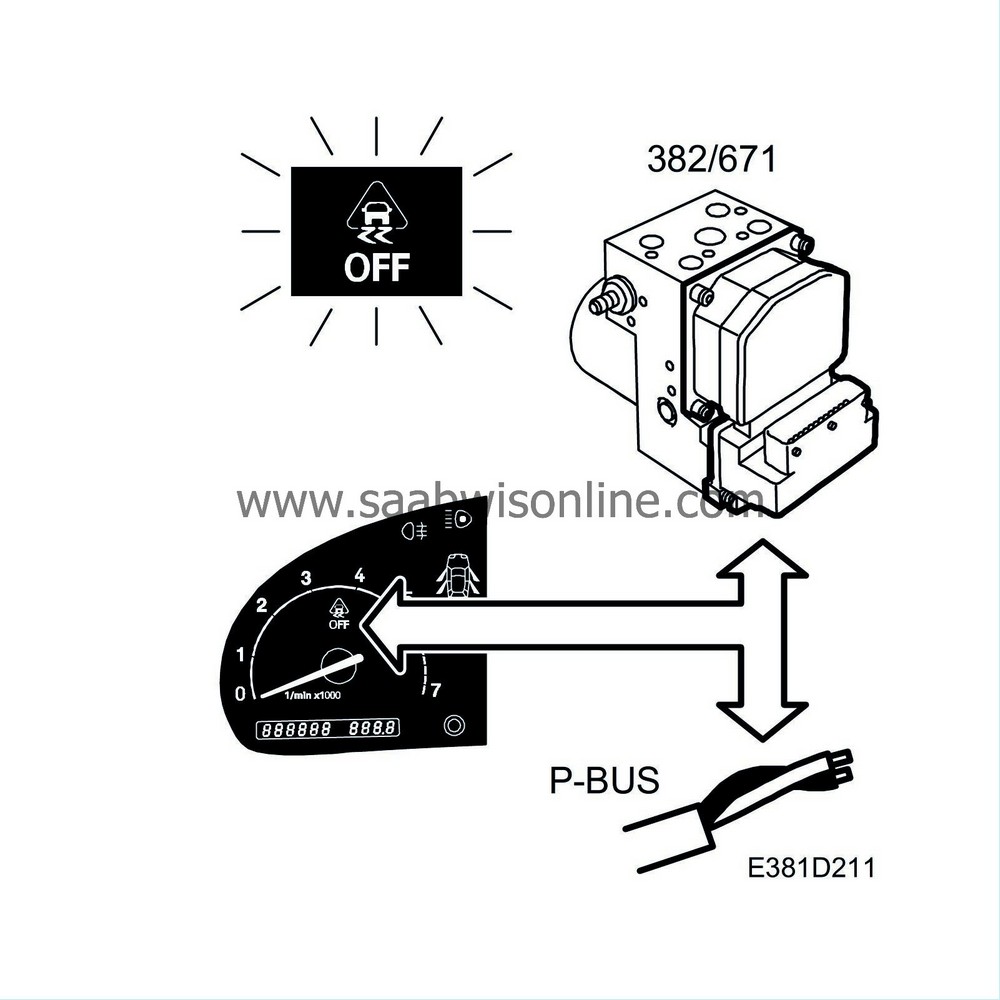
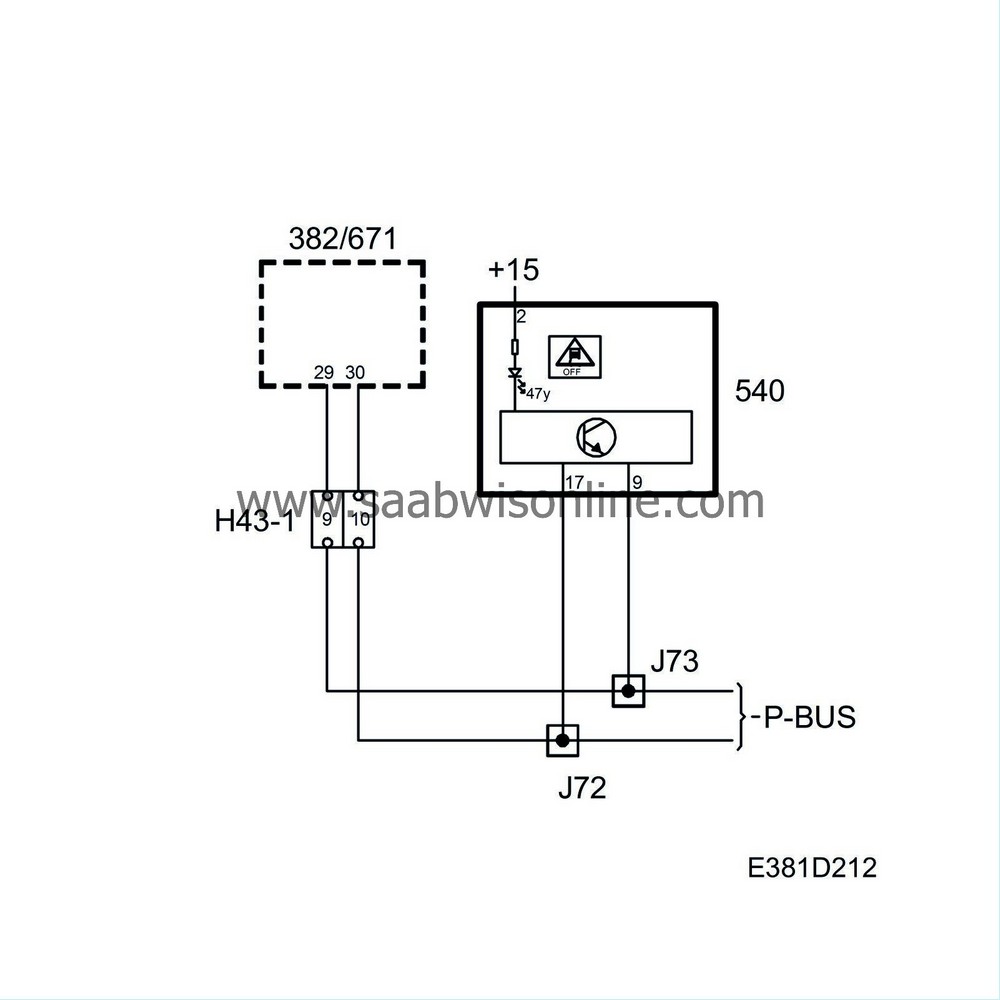
If any fault occurs in the TC/ABS or ESP system, the indicator lamp TCS/ESP OFF is lit via the P-bus. The warning lamp is also lit when the system is disconnected manually, which can be done at speeds lower than 60 km/h (37.5 mph) by pressing the TCS/ESP button. The system can be connected by pressing the TCS/ESP button at any speed, whereupon the TCS/ESP OFF indicator lamp goes off again.
When the ignition is turned on, the lamp comes on; if there is no fault, the lamp goes off again after 3-5 seconds.
Diagnostics
On a system fault which affects the ABS function, the ABS, drive brake and central warning lamps are lit.If there is no bus message from TC/ABS or ESP within 2 seconds, TCS/ESP OFF and ABS lamps are lit. If there is no bus message for a further 8 seconds, the central warning lamp and faulty brake system lamp are also lit.
| ABS warning lamp |
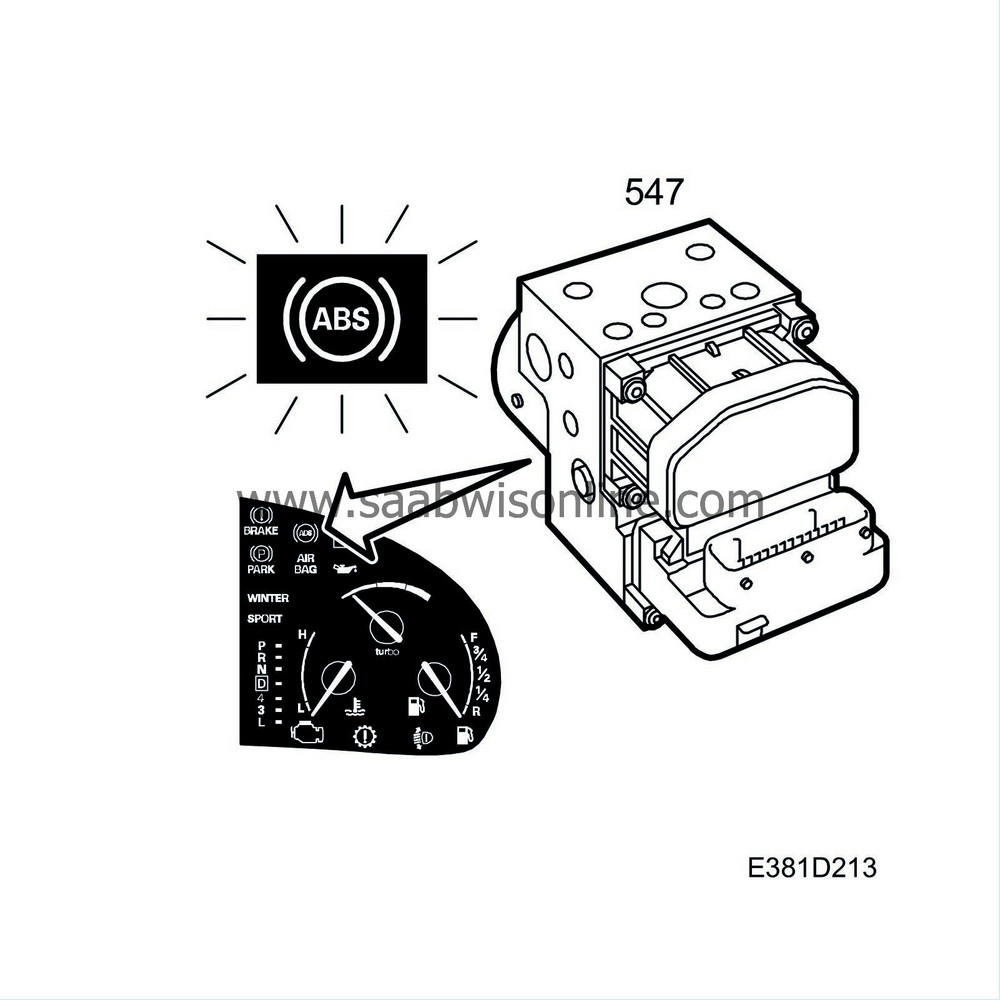
The ABS, TC/ABS or ESP control modules monitor the function of the ABS system and on a fault turn on the ABS warning lamp which is located in the RH part of the main instrument.
When the ABS lamp lights up, the anti-lock braking system is disabled and the brakes work just like a conventional braking system.
In cars with ABS (not bus-connected system) the ABS control unit grounds pin 7 in the main instrument whereupon the control module lights the warning lamp.
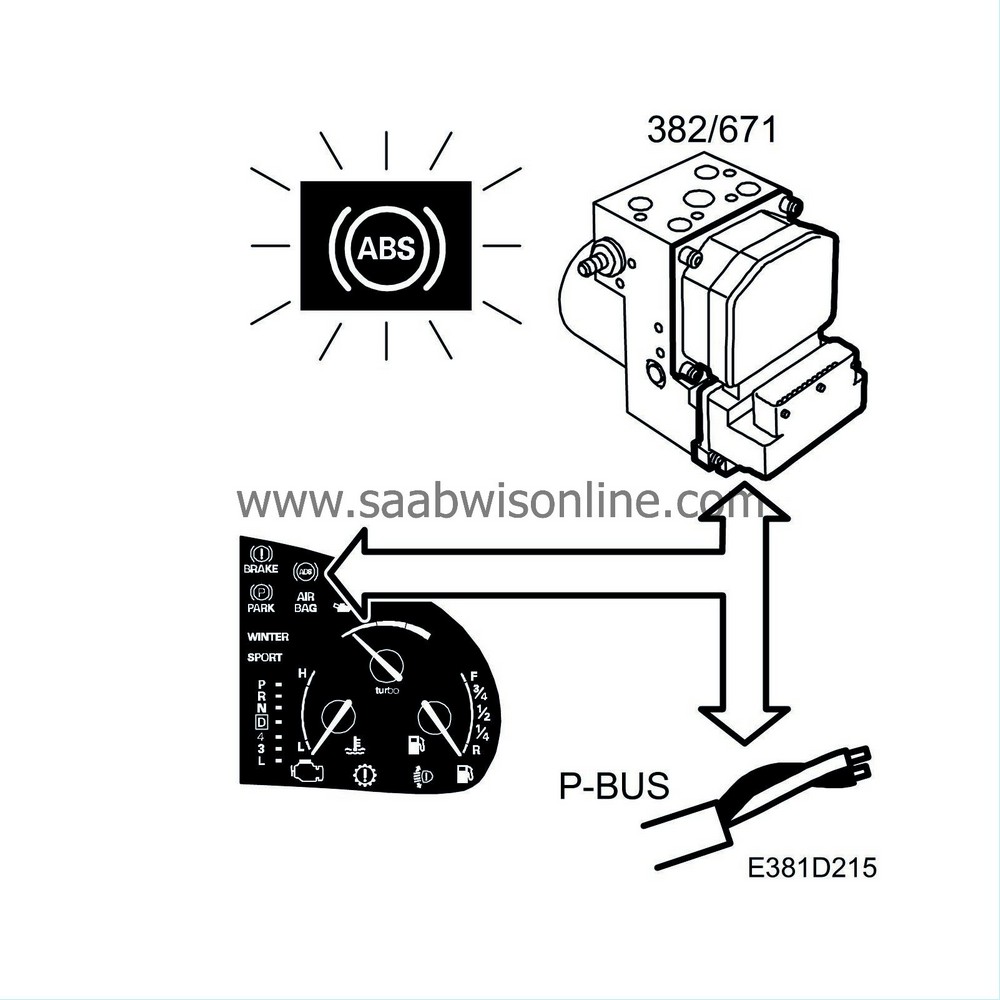
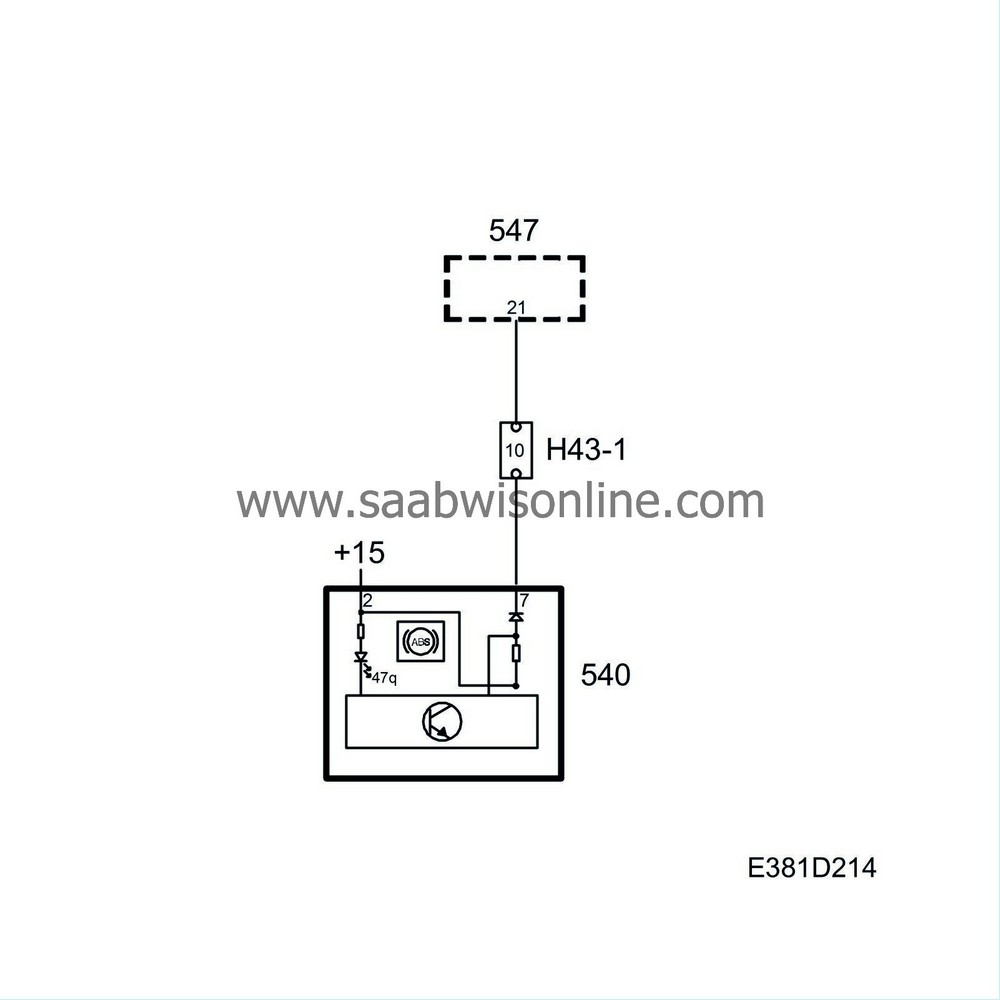
In cars with TC/ABS or ESP (bus-connected system), the main instrument receives information on the bus to turn the lamp on/off.
The TC/ABS or ESP control module lights the lamp when the ignition is turned on, if there is no fault the lamp goes off after around 3 seconds.
When the ABS warning lamp is lit, the central warning lamp comes on and at engine speeds higher than 300 rpm, MIU sends a request to SID to activate the acoustic signal.
Diagnostics
The function has no diagnostics.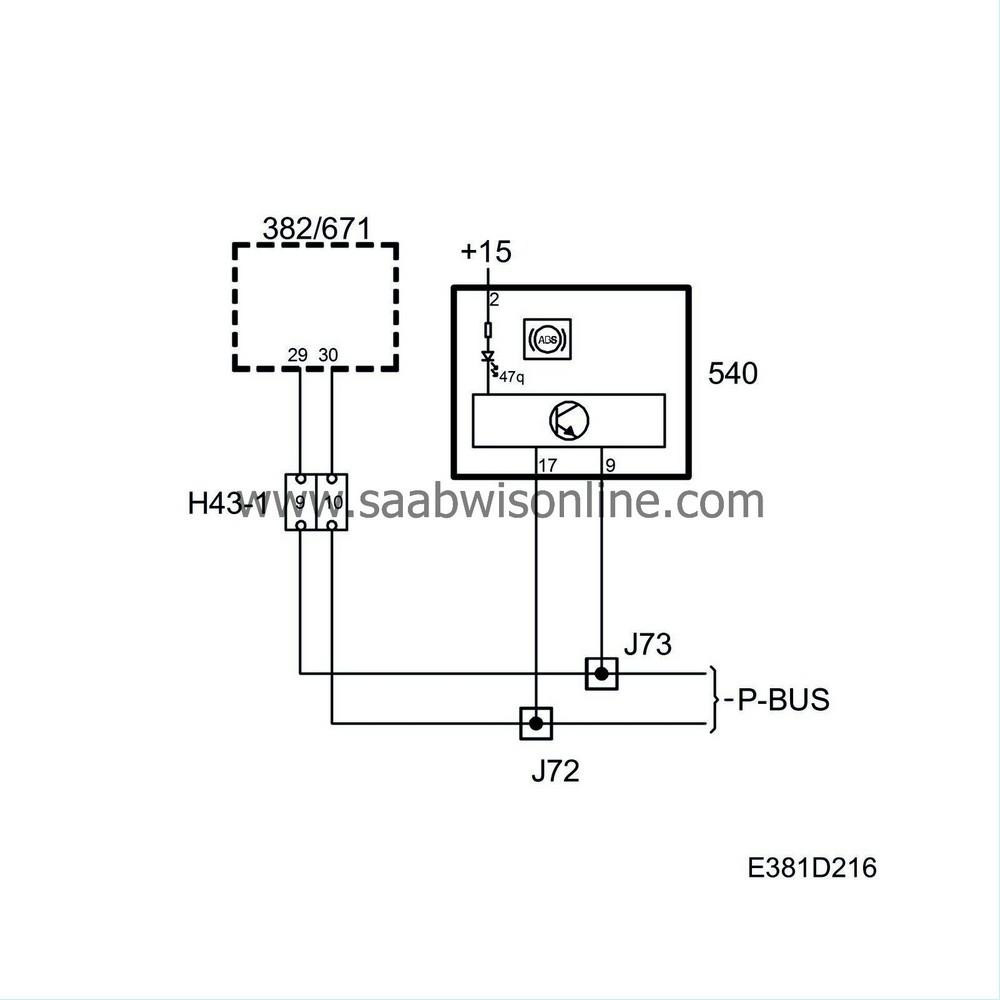
| SPORT indicator lamp |
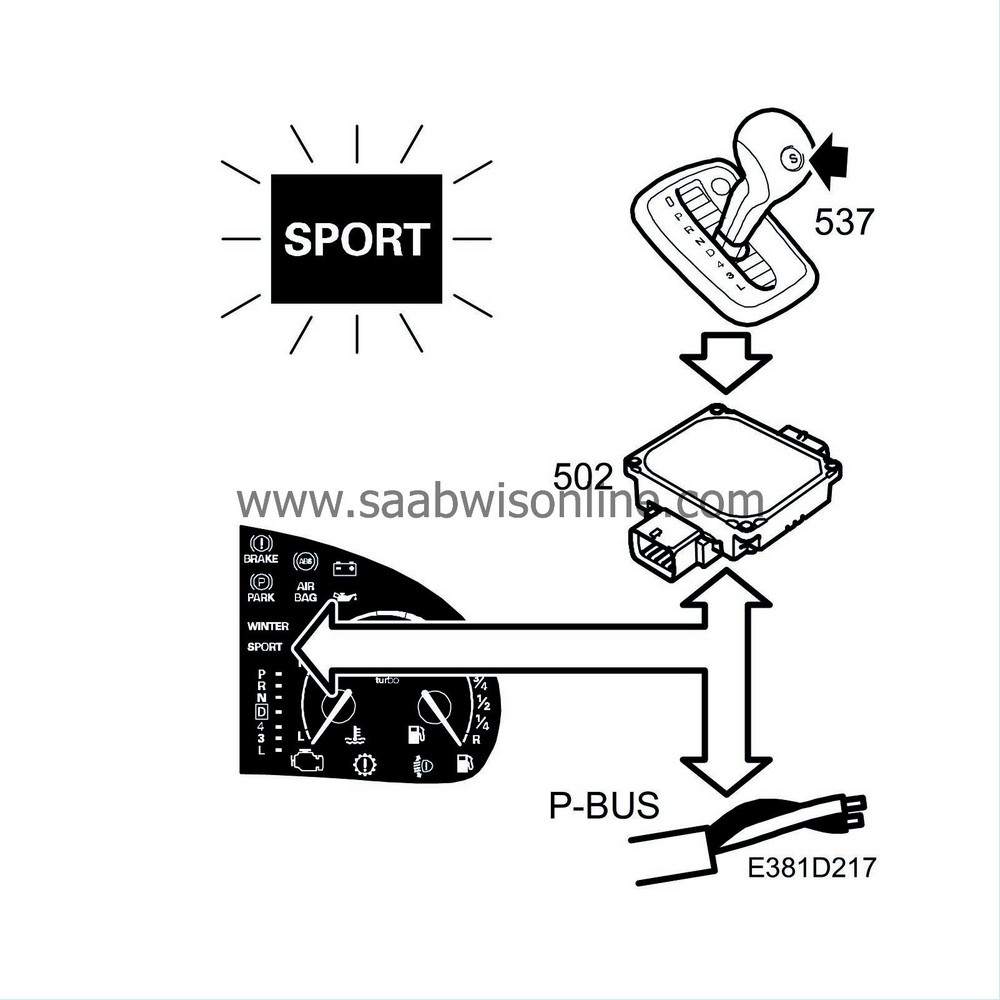

On cars fitted with automatic gearbox, the indicator lamp is lit when the SPORT button is pressed on the selector lever. The sport function can be activated when the selector is in position D, 4, 3 and L.
In SPORT mode, the transmission remains longer in each gear.
The lamp is supplied with current in the main instrument unit and grounded by the main instrument unit control module. The TCM continuously sends bus information SPORT, unit ON/OFF.
On receiving SPORT ON, the control module grounds the output of the lamp which then lights up.
The indicator lamp goes out under the following conditions:
| • |
When the sport button is depressed again.
|
|
| • |
When the transmission is in Limp-home mode.
|
|
| • |
When Winter mode is selected.
|
|
| • |
If the ignition is turned off and then on again.
|
|
| • |
The selector lever is moved to P or R.
|
|
Diagnostics
The function has no diagnostics.| WINTER indicator lamp |
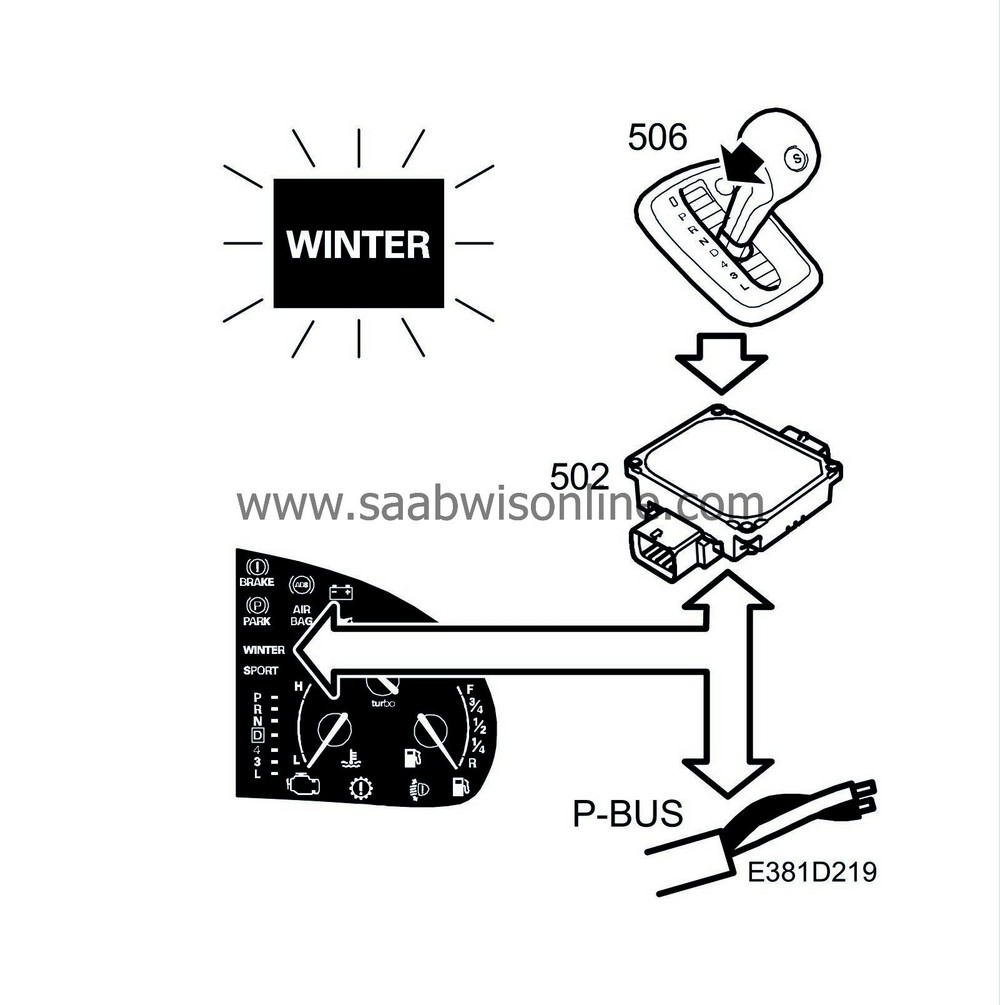
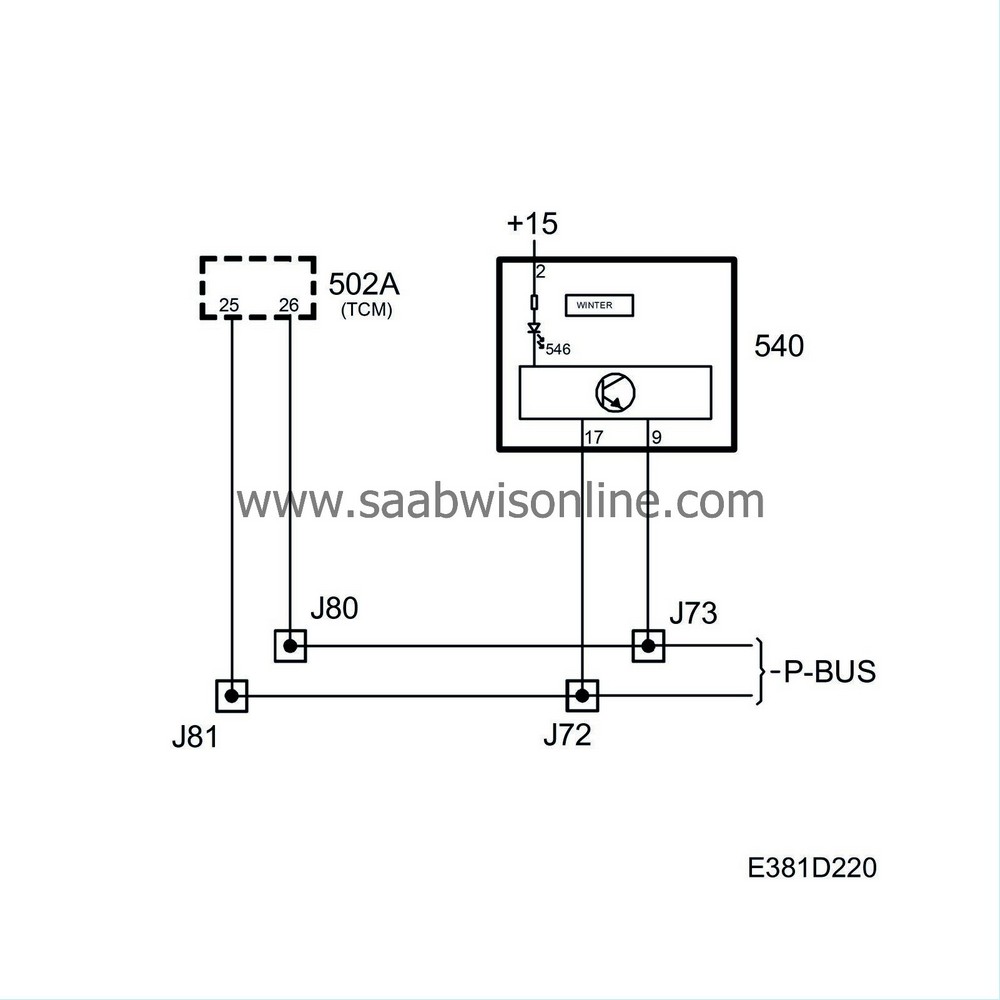
To make starting easier on slippery road surfaces, the TCM transmission is equipped with a winter mode, i.e. the car starts in 3rd gear when the winter button (W) on the selector lever is pressed.
The lamp is supplied with power in the main instrument unit and grounded internally by the main instrument. TCM continuously sends bus information WINTER ON, unit ON/OFF.
On receiving WINTER ON, the control module grounds the output of the lamp which then lights up.
The indicator lamp goes out under the following conditions:
| • |
When the Winter button is pressed again.
|
|
| • |
When the transmission is in Limp-home mode.
|
|
| • |
If the ignition is turned off and then on again.
|
|
| • |
The oil temperature in the gearbox is above 140°C.
|
|
Diagnostics
The function has no diagnostics.| CHECK GEARBOX indicator lamp |
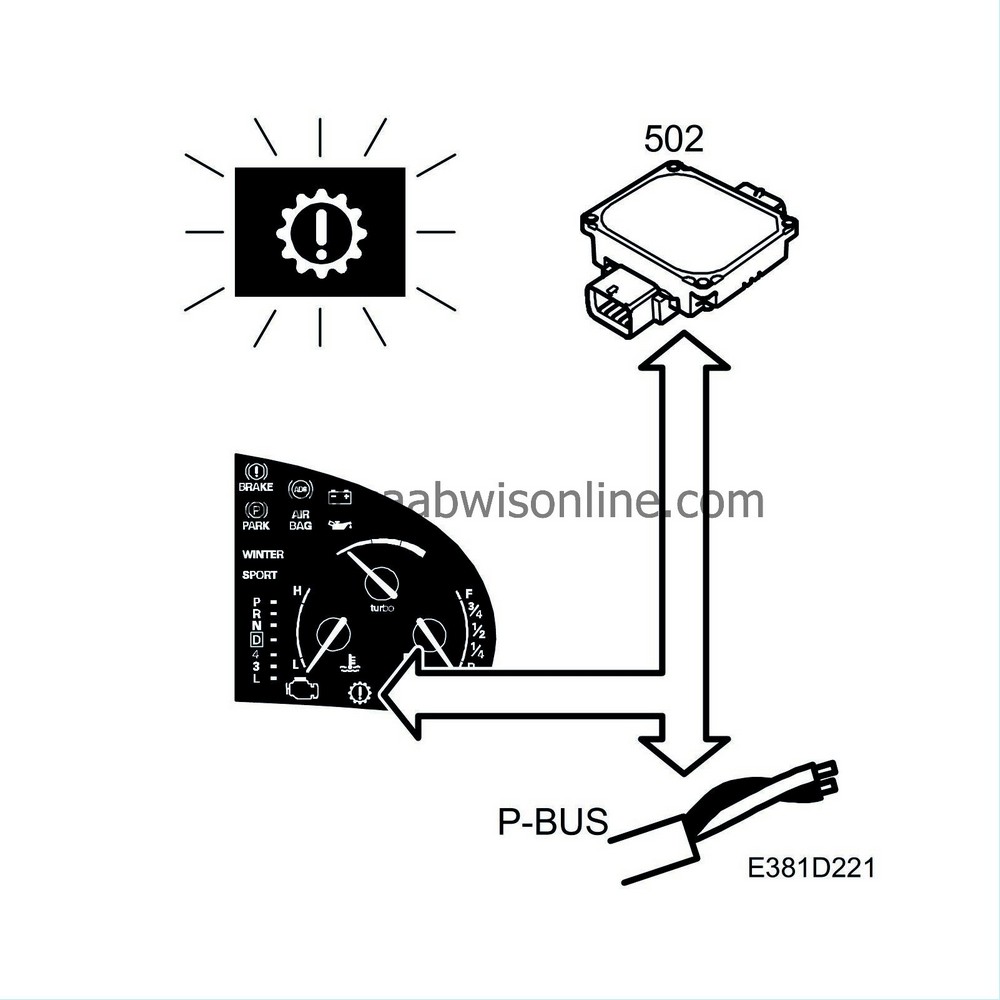
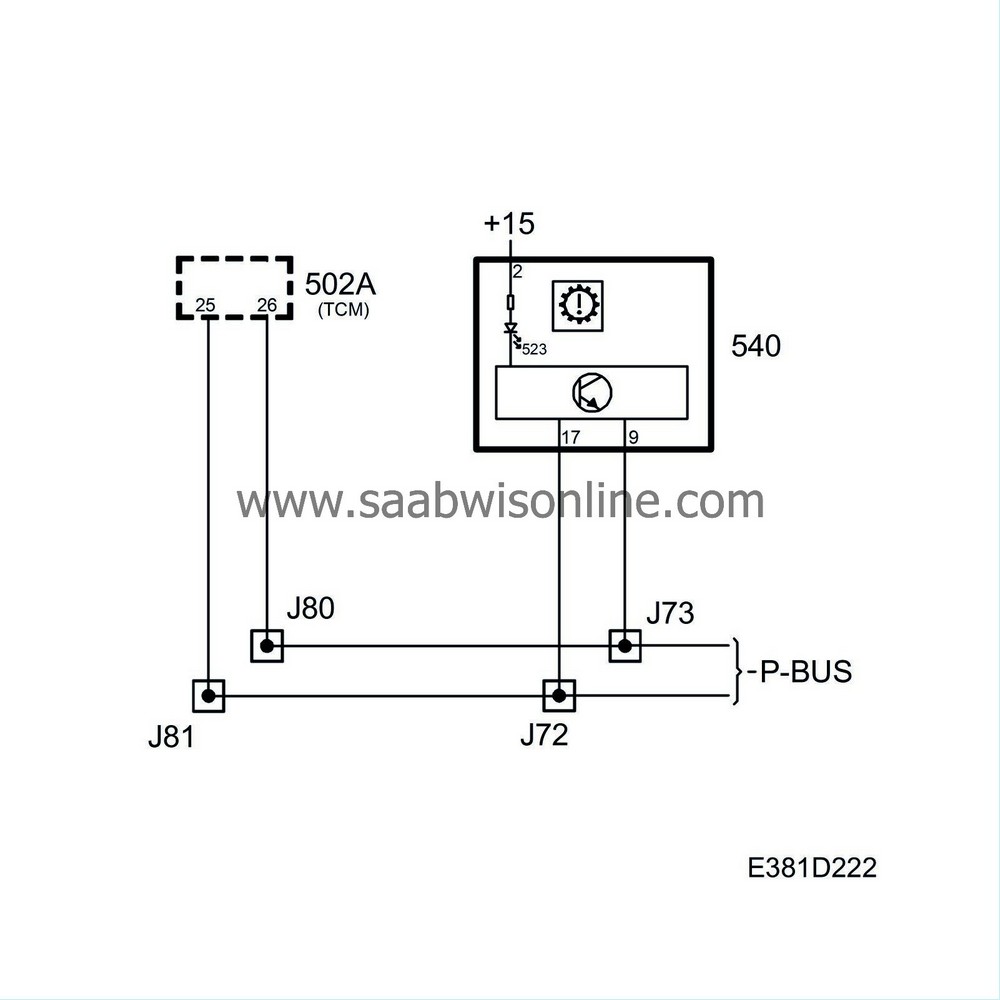
If there is a fault in the automatic transmission or its control module, the TCM lights the CHECK GEARBOX warning lamp in the main instrument unit.
The lamp is powered from the main instrument unit and grounded internally by the main instrument unit. TCM continuously sends bus information CHECK GEARBOX, unit ON/OFF.
On receiving CHECK GEARBOX ON, the control module grounds the output of the lamp which then lights up.
When the TCM sends the message CHECK GEARBOX OFF, the lamp goes out.
When the ignition is turned on, the TCM lights the lamp for approx. 3 seconds and if there is no fault the lamp will go out.
Diagnostics
The function has its own diagnostics in the sending system.| Fuel reserve indicator lamp |
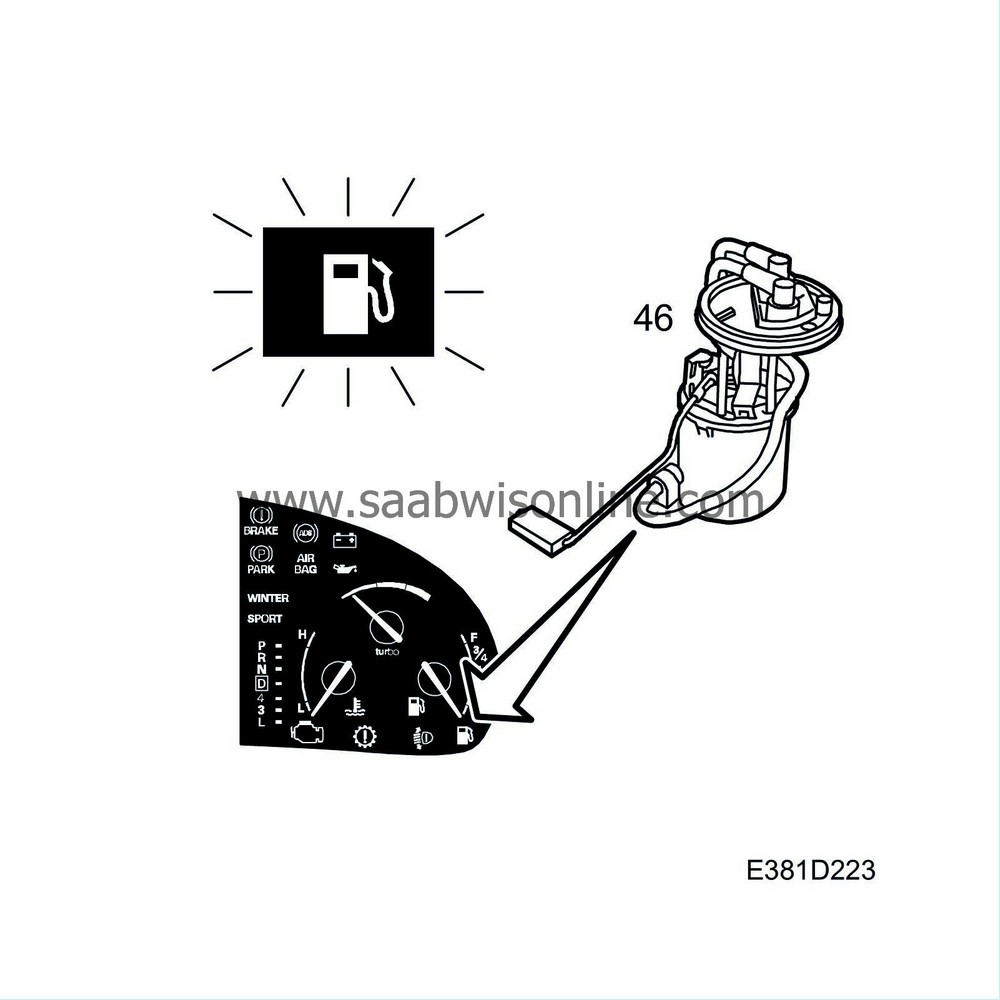
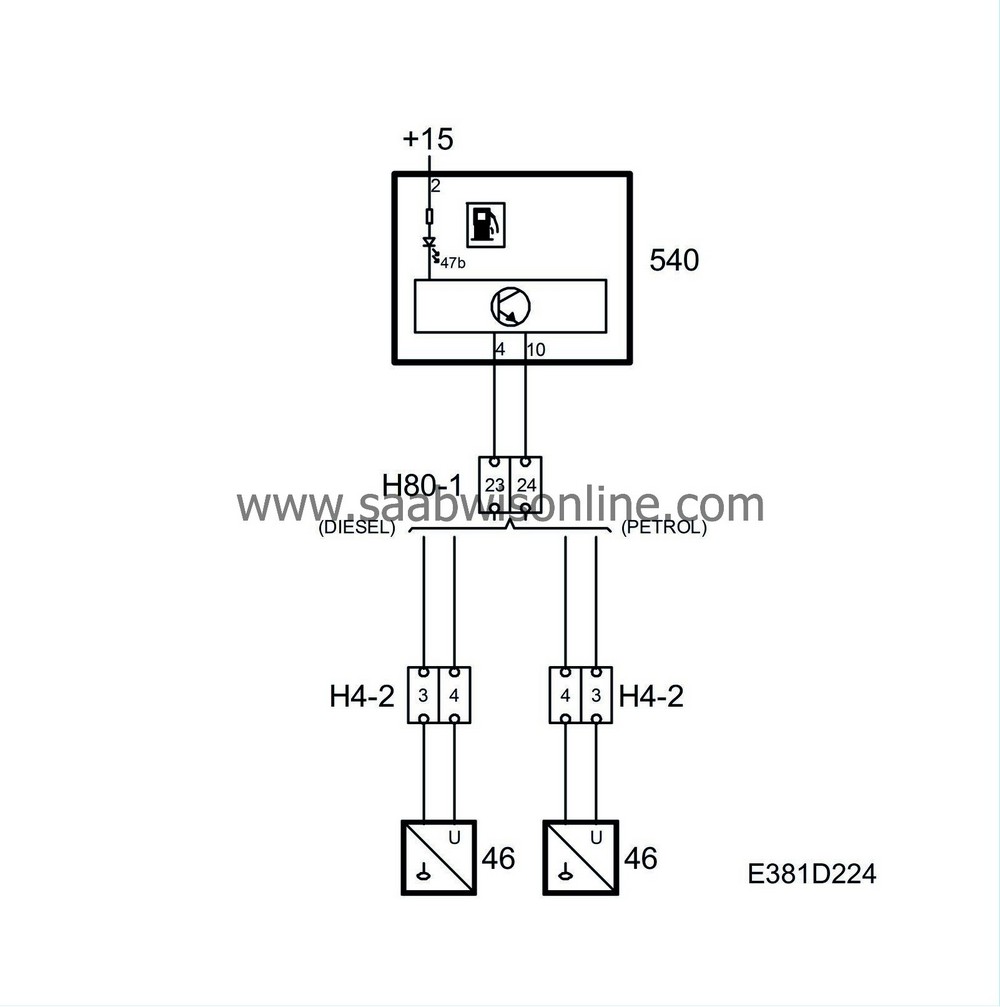
When approx. 10 litres of fuel are left, the lamp comes on to indicate the low fuel level. The lamp is powered from the main instrument unit and grounded internally by the main instrument unit.
The main instrument unit lights this lamp for three seconds when the ignition is switched on.
Diagnostics
An open circuit/short circuit sets diagnostic trouble code B1720. The gauge needle indicates 0 litres and the fuel reserve indicator lamp lights up.| Glow plug indicator lamp |
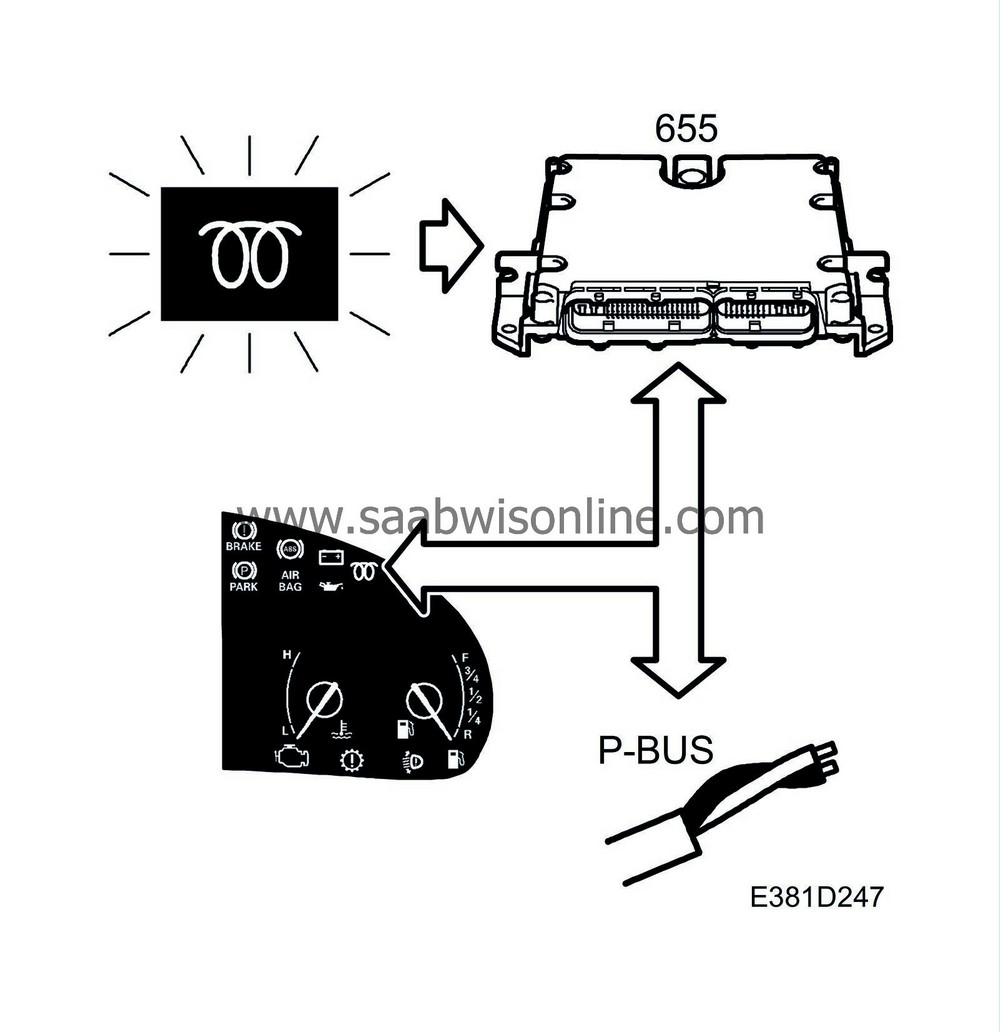
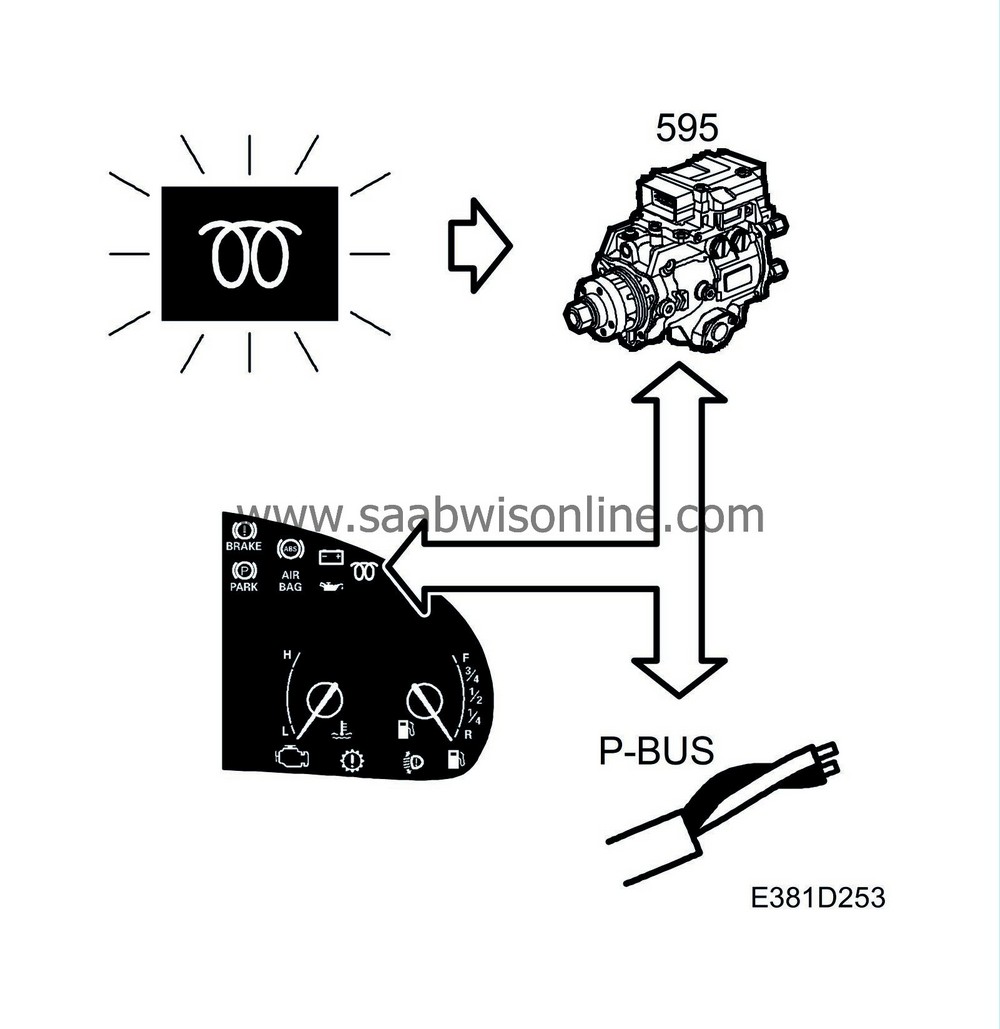
The glow plug indicator lamp comes on during preheating.
The lamp is powered from the main instrument unit and grounded internally by the main instrument unit. The diesel engine control module continuously sends the bus information Glow Plug, unit ON/OFF.
On Glow Plug ON, the control module grounds the output for the lamp which is then lit.
Diagnostics
The function has diagnostics in the sending system.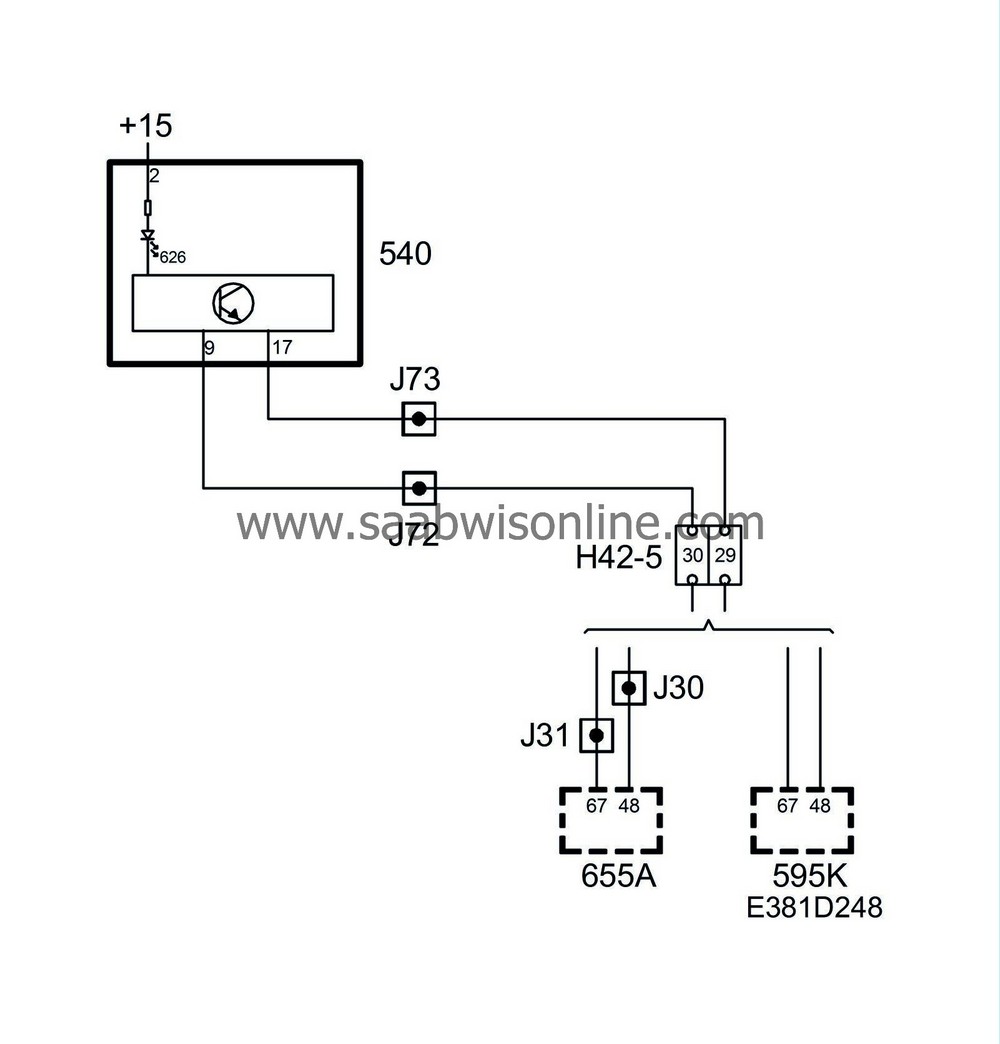
| CHECK ENGINE indicator lamp |
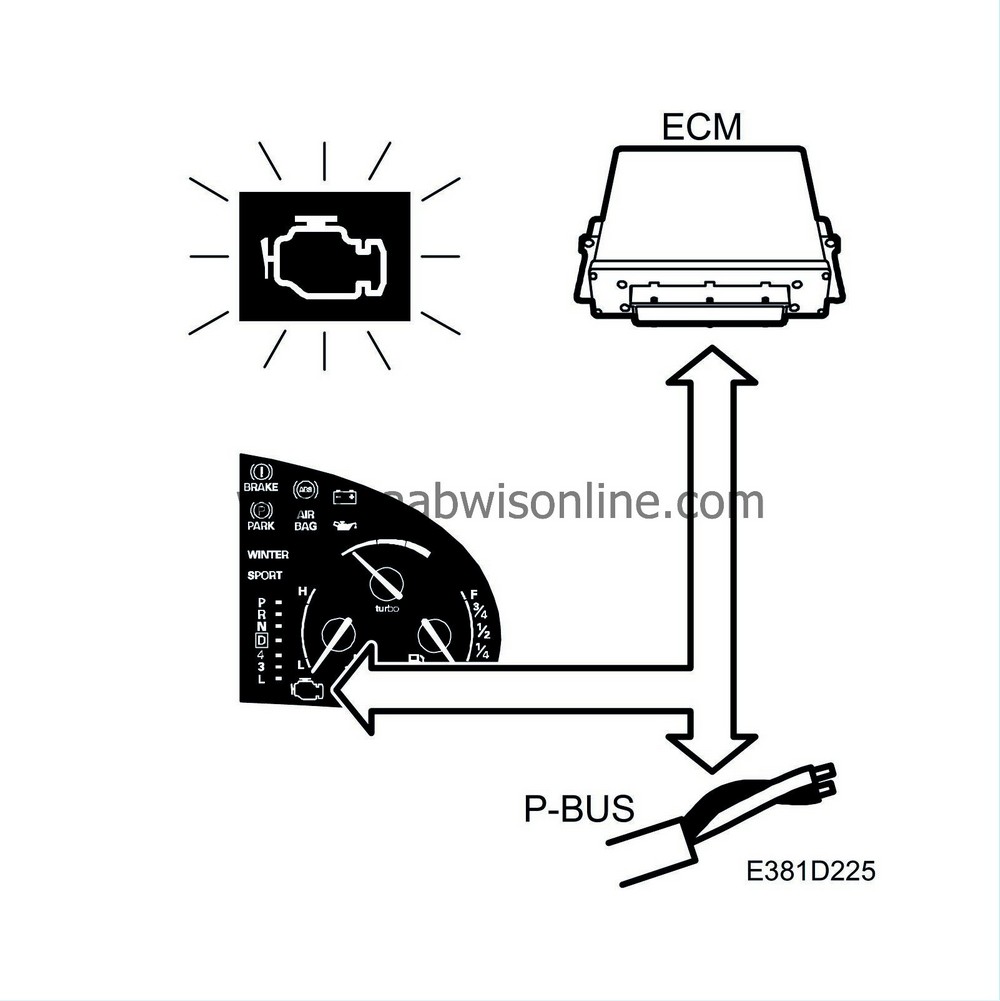
The CHECK ENGINE lamp (MIL) warns the driver when a fault occurs in the engine management system.
The lamp is powered from the main instrument unit and grounded internally by the main instrument unit. The engine control module continuously sends the bus information CHECK ENGINE, unit ON/OFF.
On receiving CHECK ENGINE ON, the control module grounds the output of the lamp which then lights up.
In certain markets, the TCM (transmission control module) lights the CHECK ENGINE lamp.
If the engine control module changes status on the message to CHECK ENGINE OFF, the light goes out.
On ignition ON, the lamp comes on until the engine starts; if there is no fault, the engine control module sends the bus information CHECK ENGINE OFF and the lamp goes out.
Diagnostics
The function has its own diagnostics in the sending system.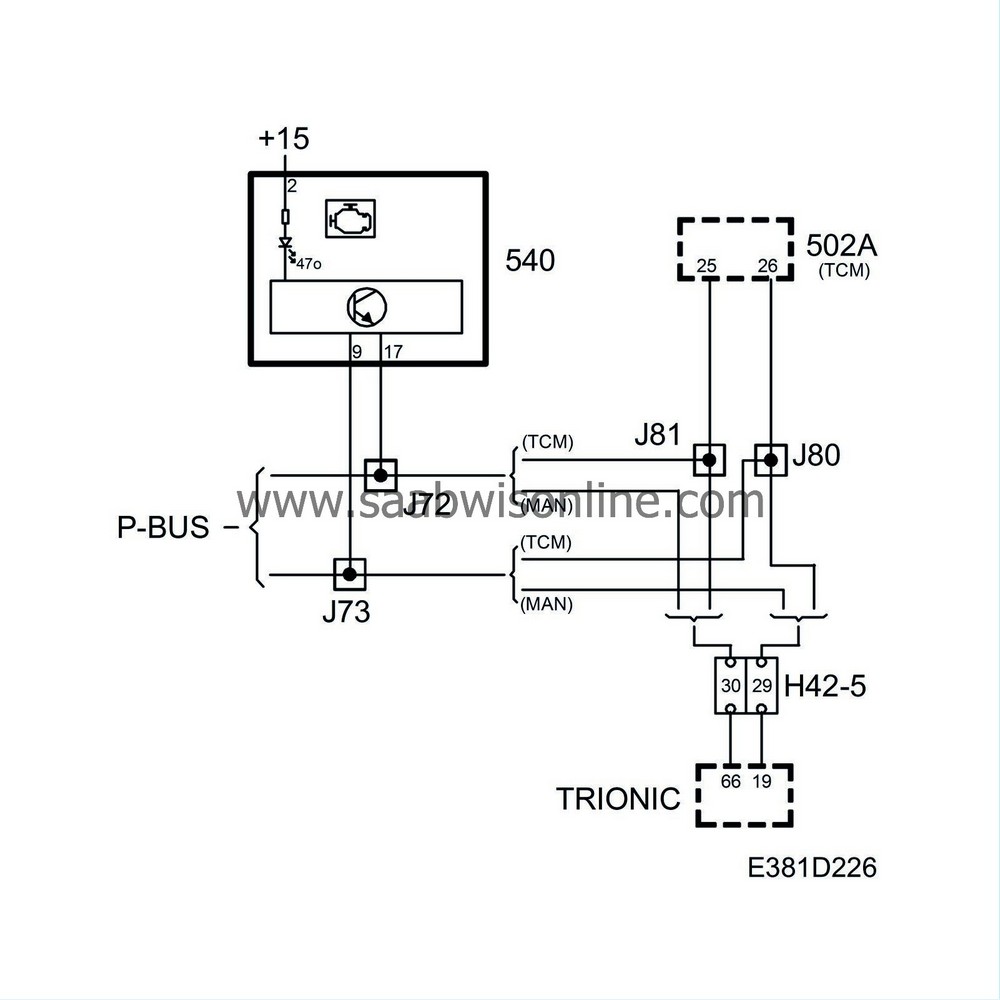

| Direction indicator repeater lamps RH and LH |
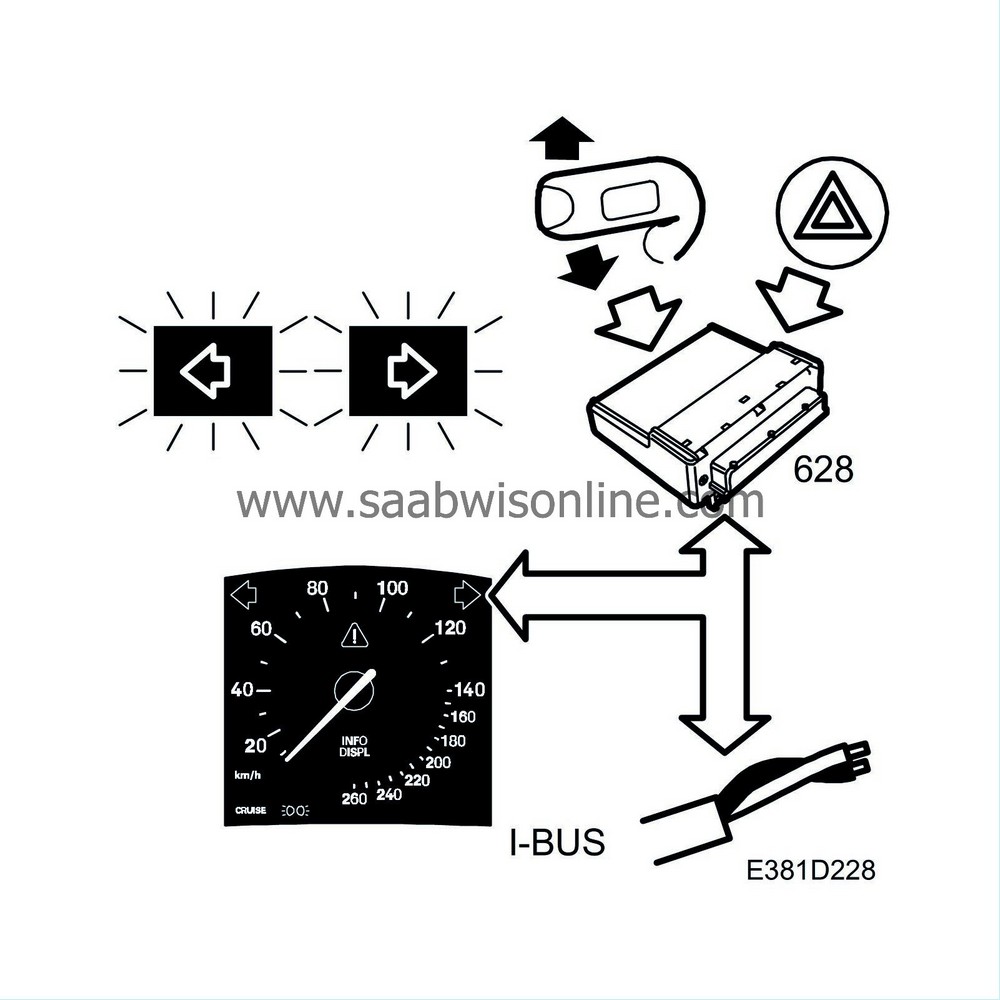
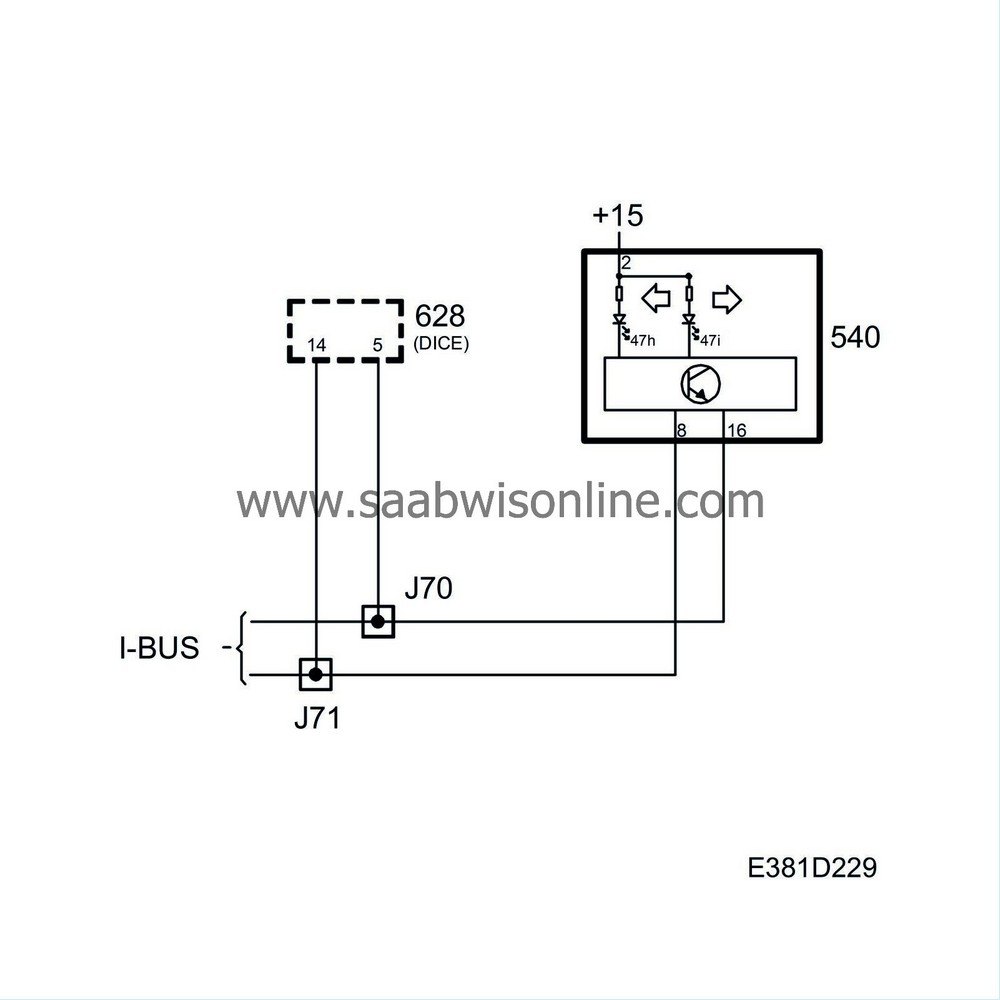
The repeater lamps are situated in the upper part of the main instrument unit and show when the direction indicators are on.
The lamps are powered from the main instrument unit and grounded internally by the main instrument unit. DICE continuously sends bus information status for INDICATORS RIGHT and INDICATORS LEFT, unit ON/OFF.
On receiving DIRECTION INDICATORS ON, the control module grounds the output of the lamp in question which then lights up.
| Example |
If the LH direction indicators are activated, DICE will change the status of the information DIRECTION INDICATORS LEFT ON/OFF at the same time as the direction indicator lamps are lit. In this way, the main instrument unit control module can synchronise the flashing of the repeater lamps with the direction indicator lamps.
The SID also activates the TIC-TAC sound at the same time as the lamps flash.
The function is the same for the RH direction indicators.
| Hazard flashers |
The function for the hazard flashers is the same as for the direction indicators LH/RH except that both lamps are activated at the same time.
When the hazard flashers are activated and the ignition is OFF, the indicator lamps will not flash.
Diagnostics
The function has no diagnostics.| Cruise indicator lamp |
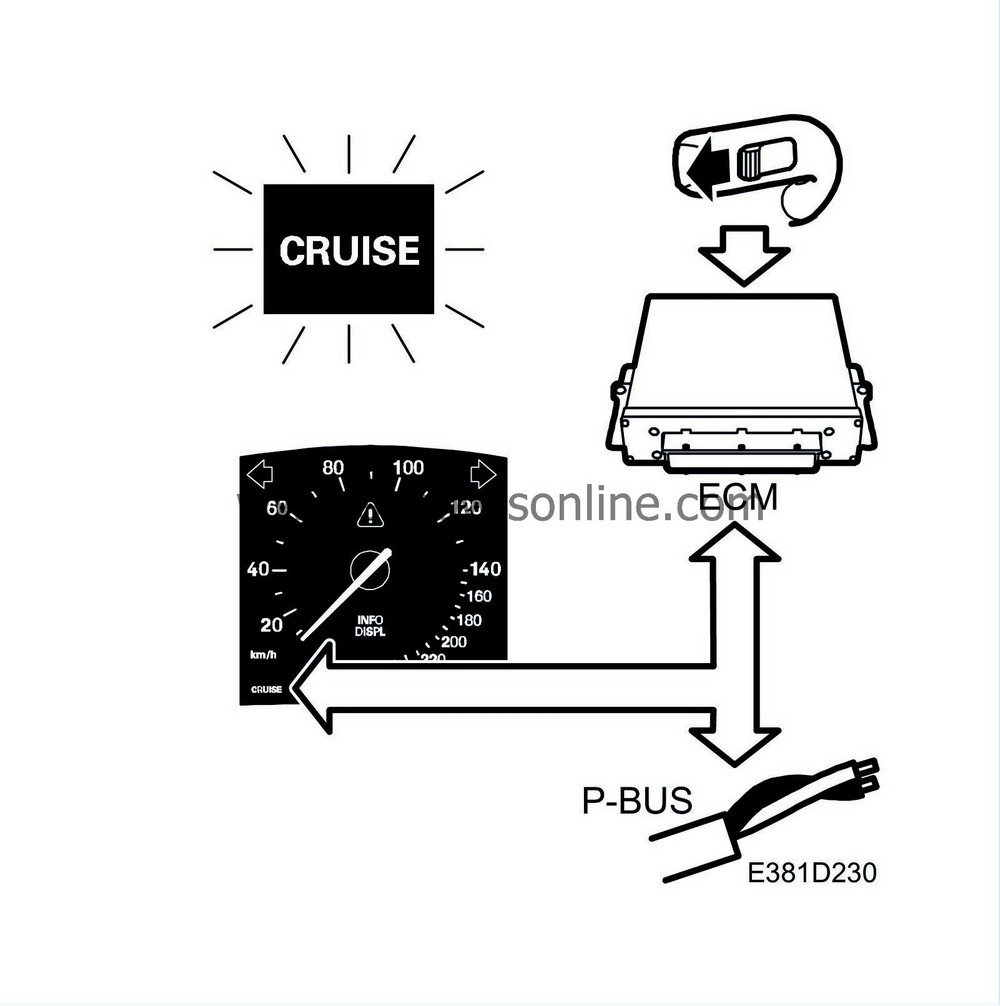
The main instrument unit incorporates a CRUISE indicator lamp that lights up when Cruise Control is engaged.
The lamp is powered from the main instrument unit and grounded internally by the main instrument unit. The engine control module continuously sends bus information CRUISE lamp, unit ON/OFF.
On receiving CRUISE Lamp ON, the control module grounds the output of the lamp which then lights up.
If the cruise control is disconnected, the engine control module changes the status on information to CRUISE Lamp OFF and the lamp goes out.
Diagnostics
The function has its own diagnostics in the sending system.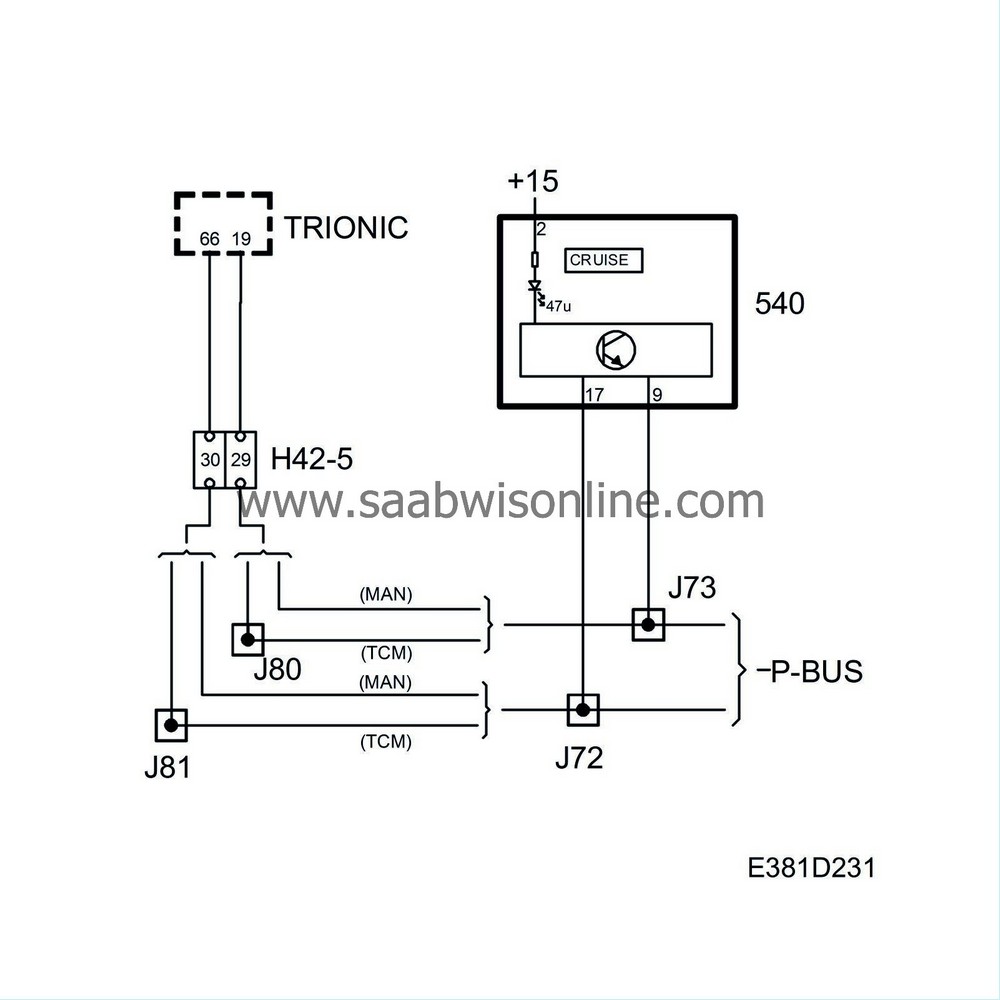
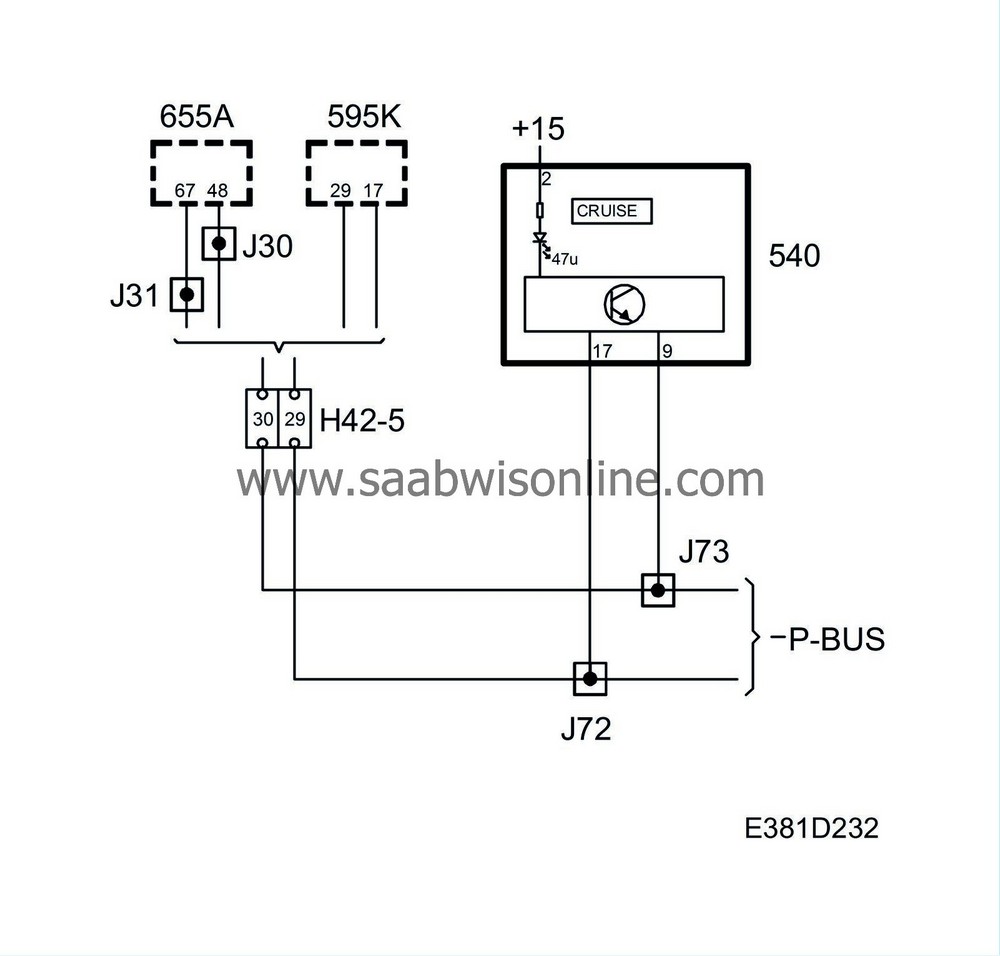
| SHIFT UP indicator lamp |
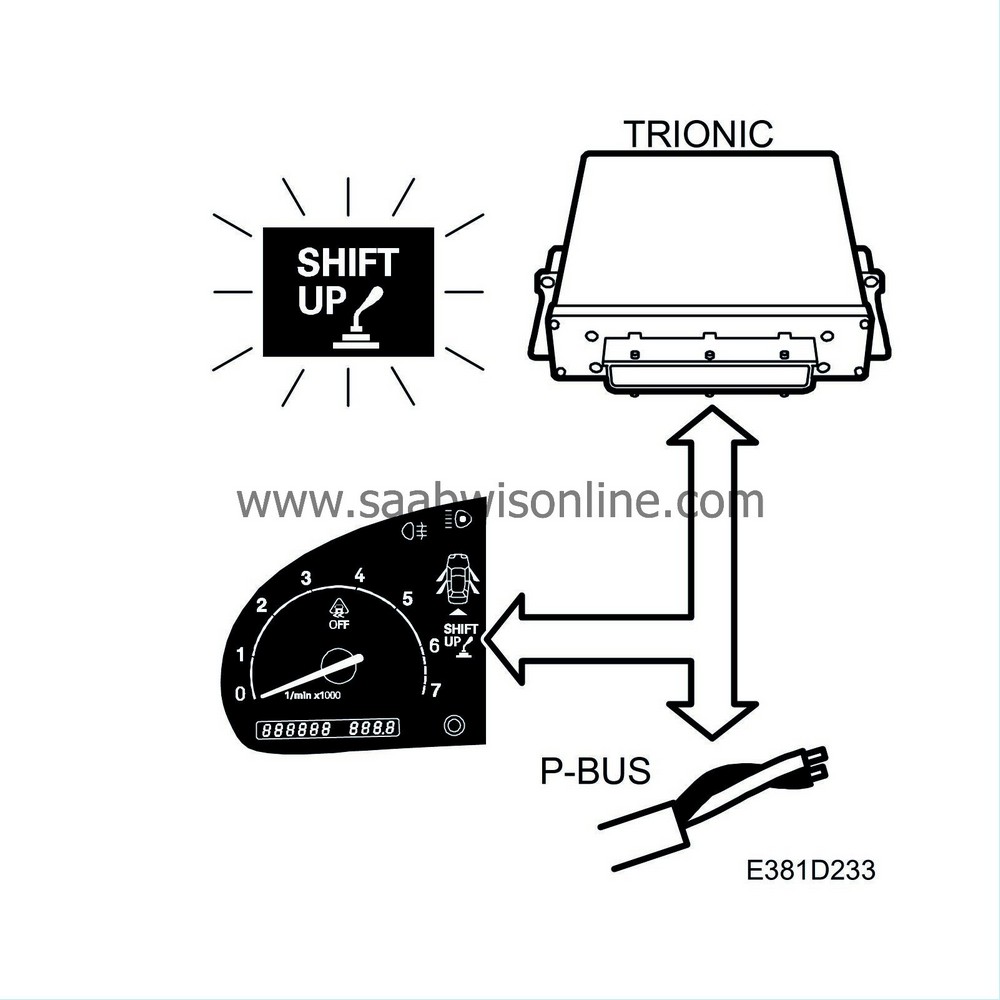
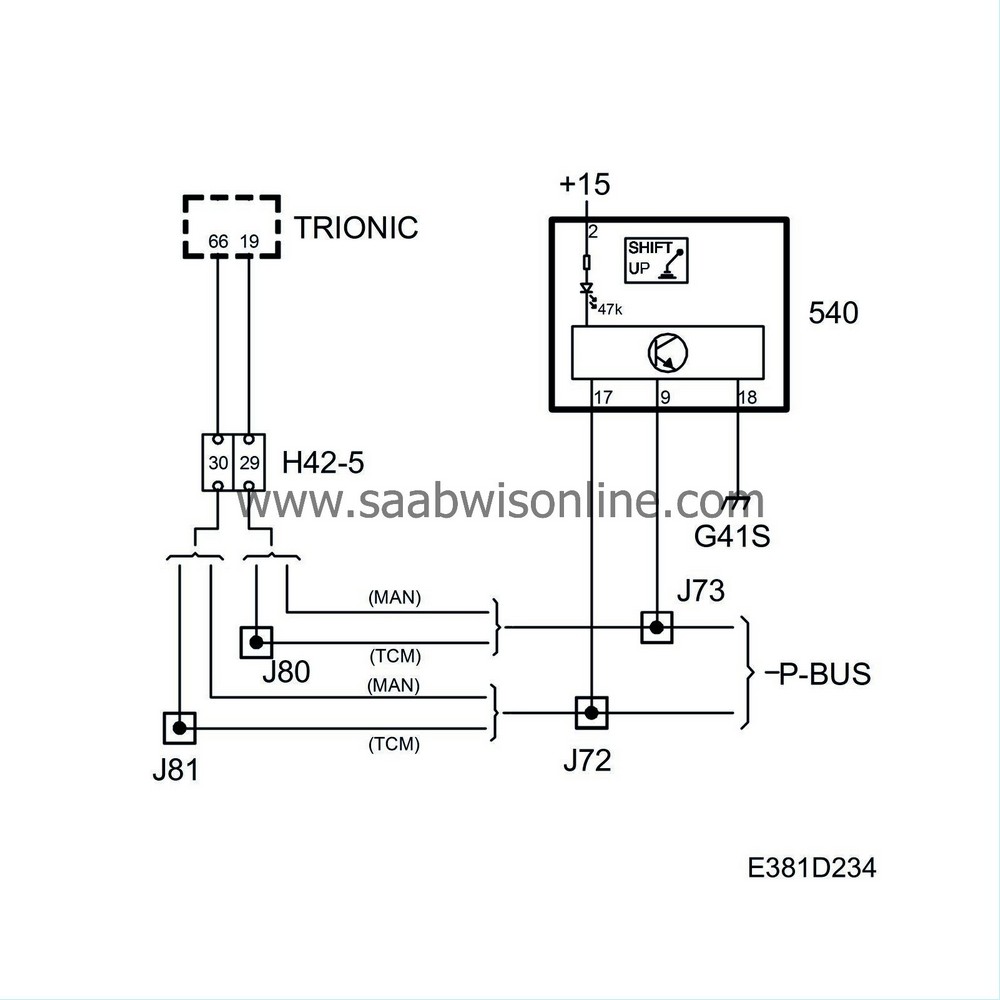
To achieve low fuel consumption, the SHIFT-UP indicator lamp on the main instrument unit lights up when a higher gear should be engaged.
The lamp is powered from the main instrument unit and grounded internally by the main instrument unit. The engine control module continuously sends bus information SHIFT UP, unit ON/OFF.
On receiving SHIFT-UP ON, the control module grounds the output of the lamp which then lights up.
When the shift has been made, the engine control module changes the status of the information to SHIFT UP OFF and the lamp goes out.
Diagnostics
The function has its own diagnostics in the sending system.| Lights-on indicator lamp |
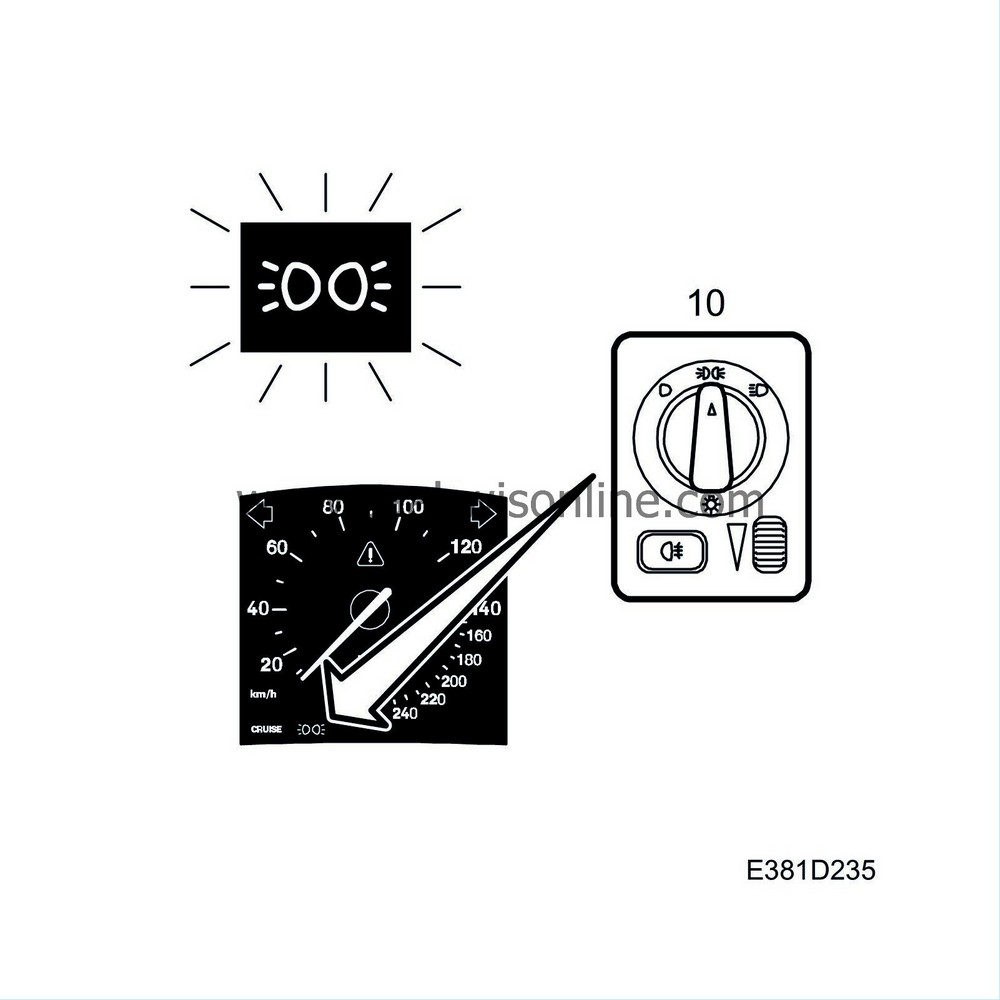
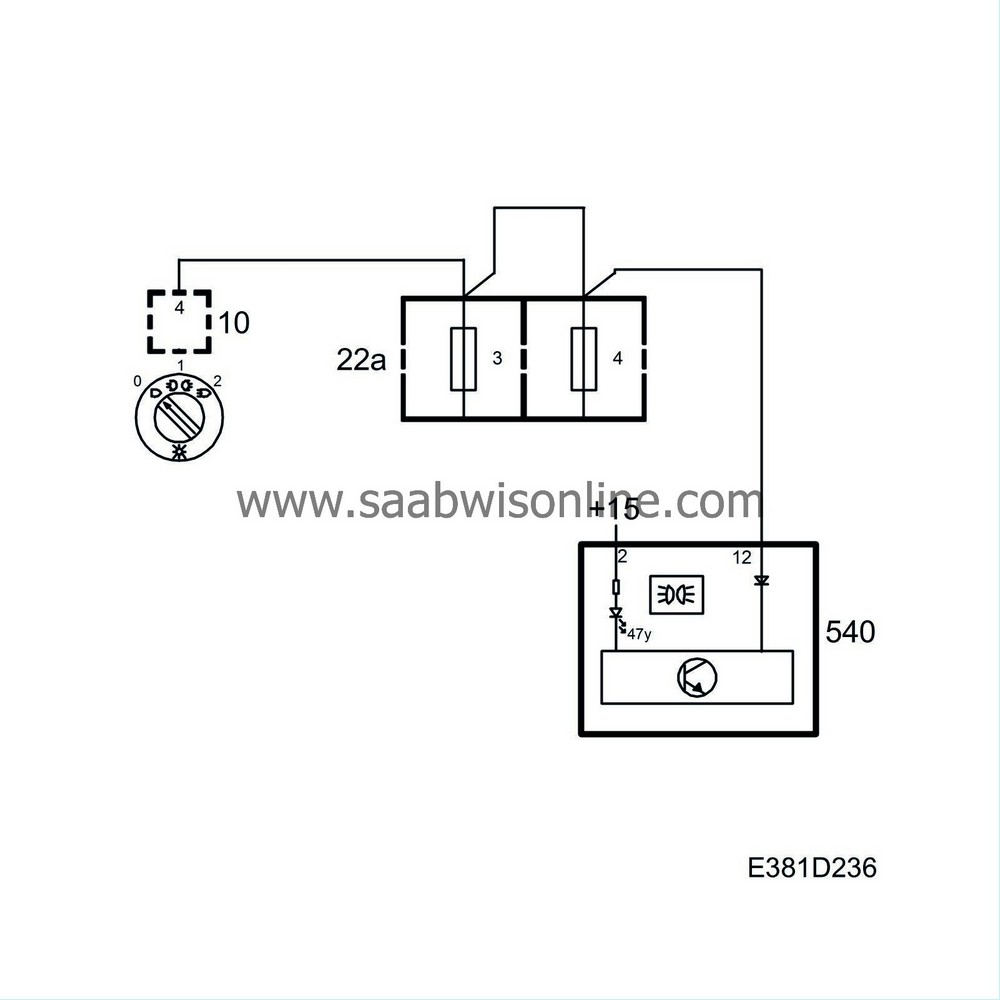
An indicator lamp shows when the headlamps are switched on. The lamp is situated below the speedometer.
The lamp is powered from the main instrument unit and grounded internally by the main instrument unit. The indicator lamp is turned on by the control module when the main instrument unit input (pin 12) is powered with B+ from the light switch.
Diagnostics
The function has no diagnostics.| Indicator lamp, rear fog light |
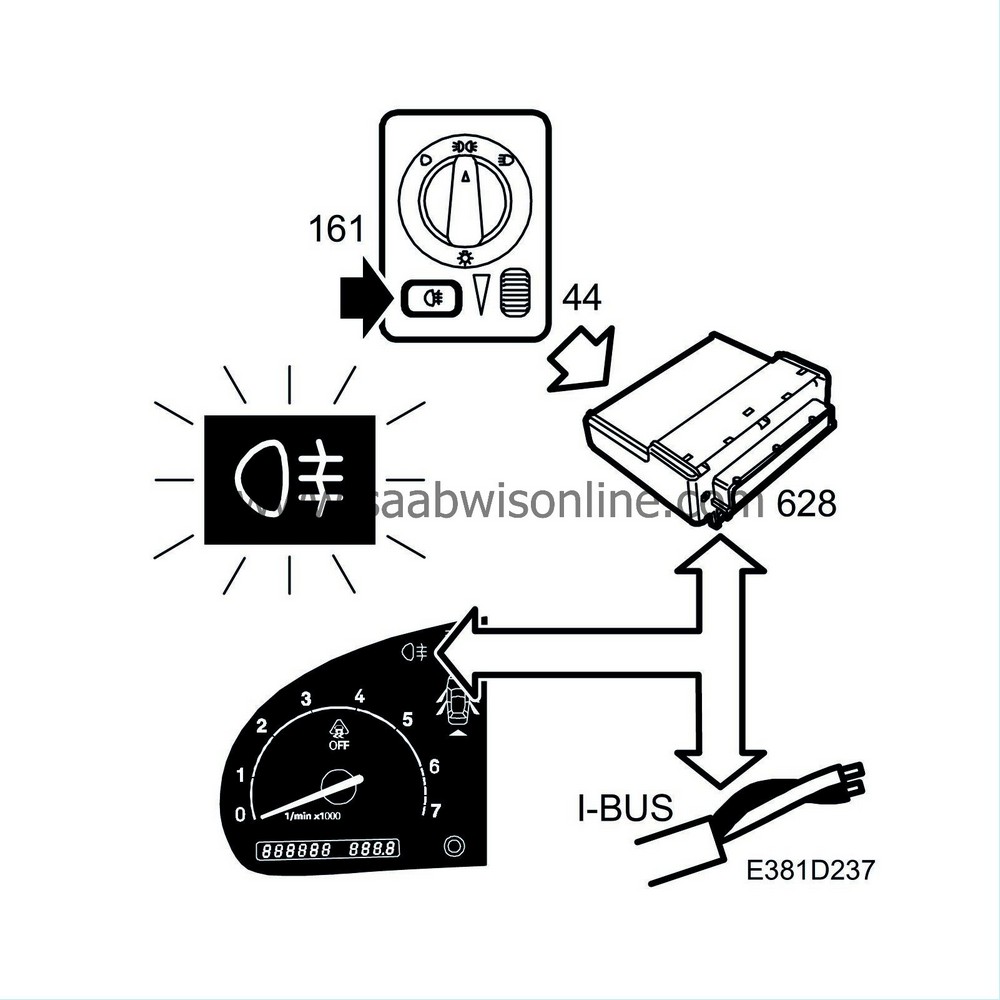
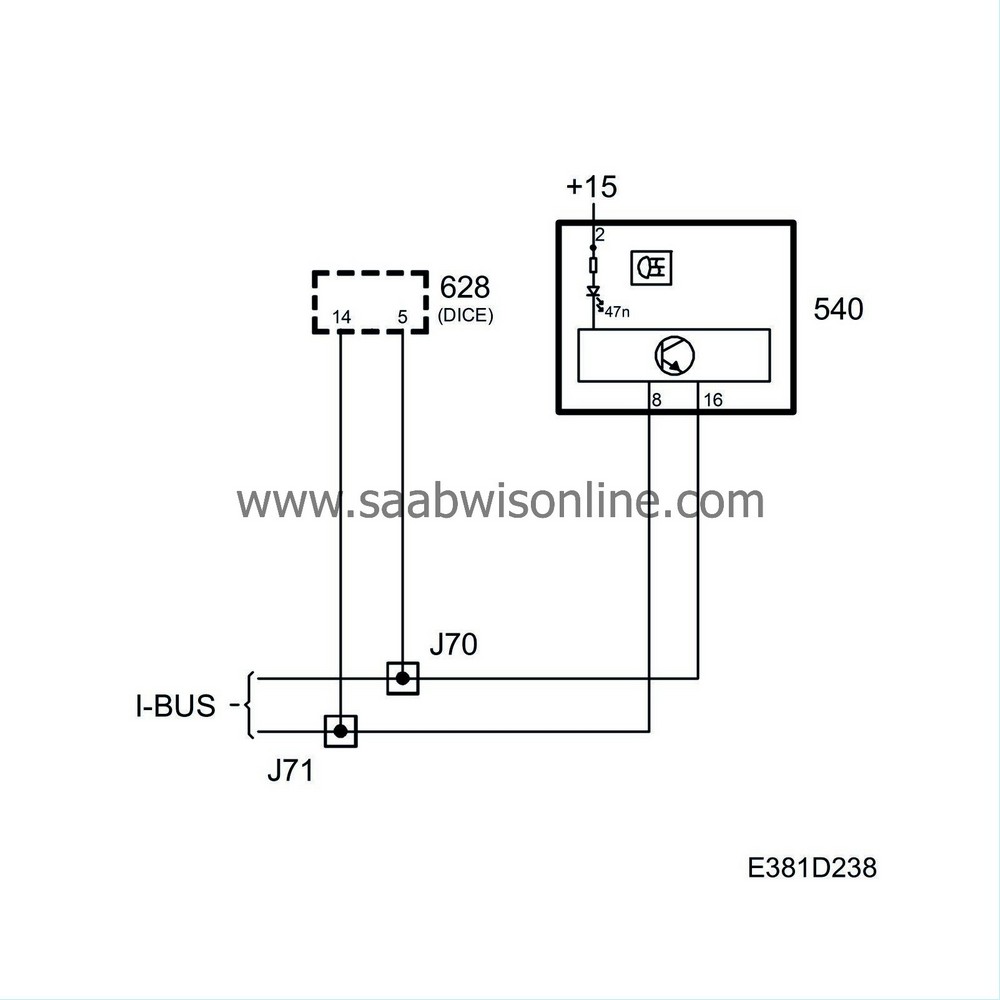
The indicator lamp for the rear fog light is situated in the upper RH corner and informs the driver when the rear fog light is switched on.
The lamp is powered from the main instrument unit and grounded internally by the main instrument unit. DICE continuously sends bus information REAR FOG LIGHT, unit ON/OFF.
On receiving REAR FOG LIGHT ON, the control module grounds the output of the lamp which then lights up.
If DICE changes the status of the bus information to REAR FOG LIGHT OFF, the lamp goes out.
Diagnostics
The function has its own diagnostics in the sending system.| Main beam indicator lamp |
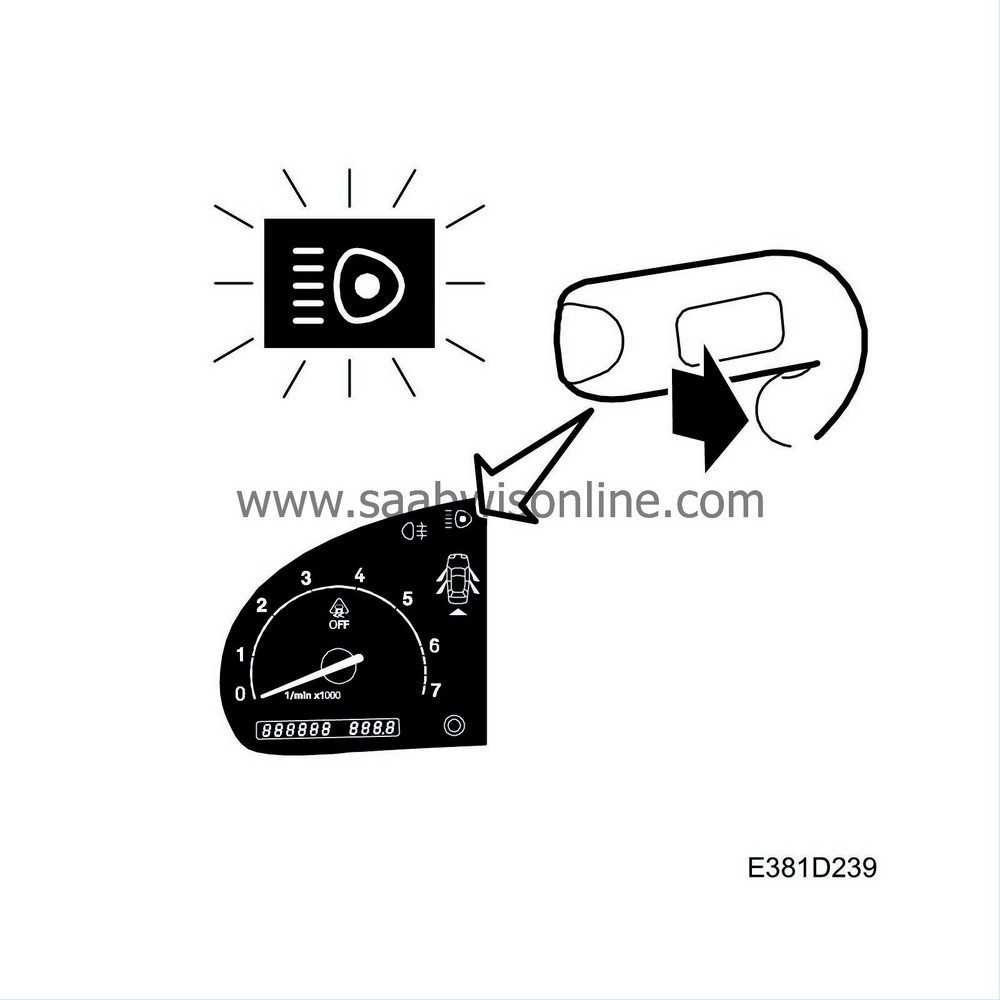
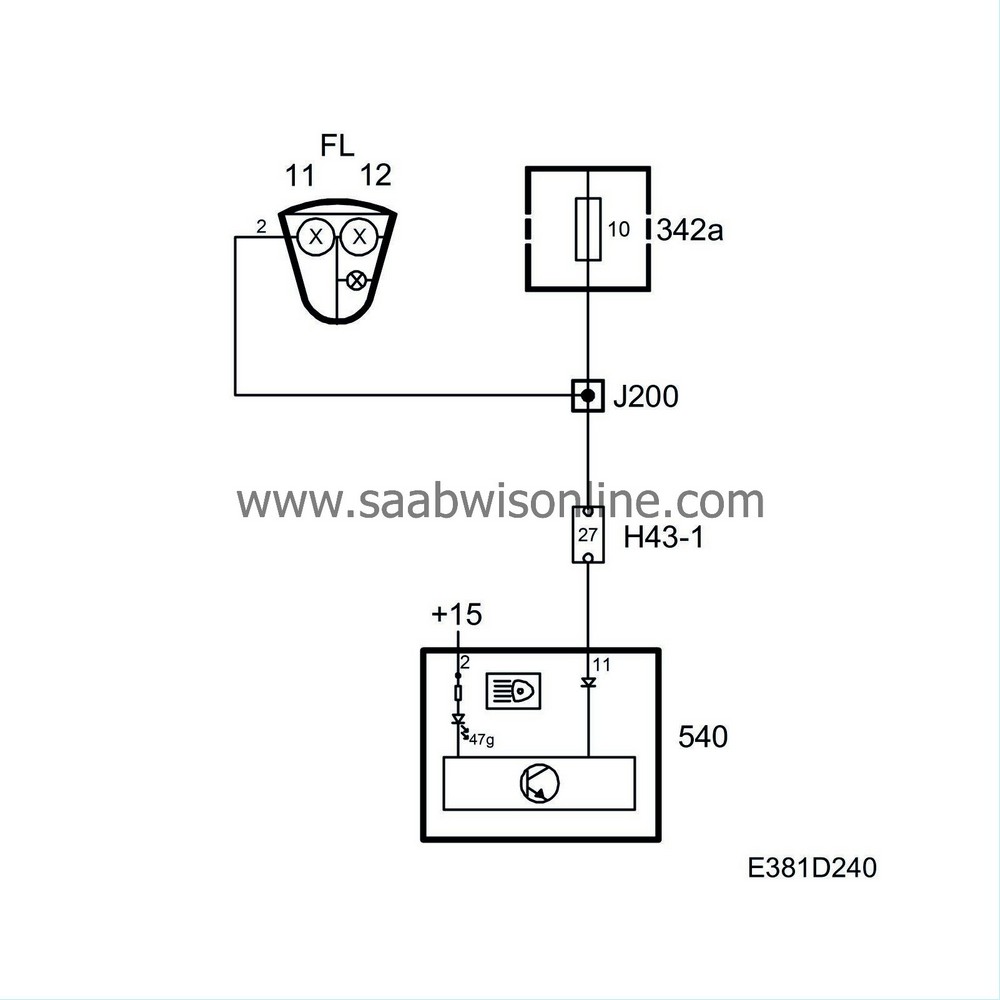
The indicator lamp is situated in the upper LH corner and informs the driver that main beams are switched on.
The lamp is powered from the main instrument unit and grounded internally by the main instrument unit. The indicator lamp is turned on by the control module when the main instrument unit input (pin 11) is powered with B+ from the main beam fuse 10.
Diagnostics
The function has no diagnostics.| Xenon lamp system indicator |
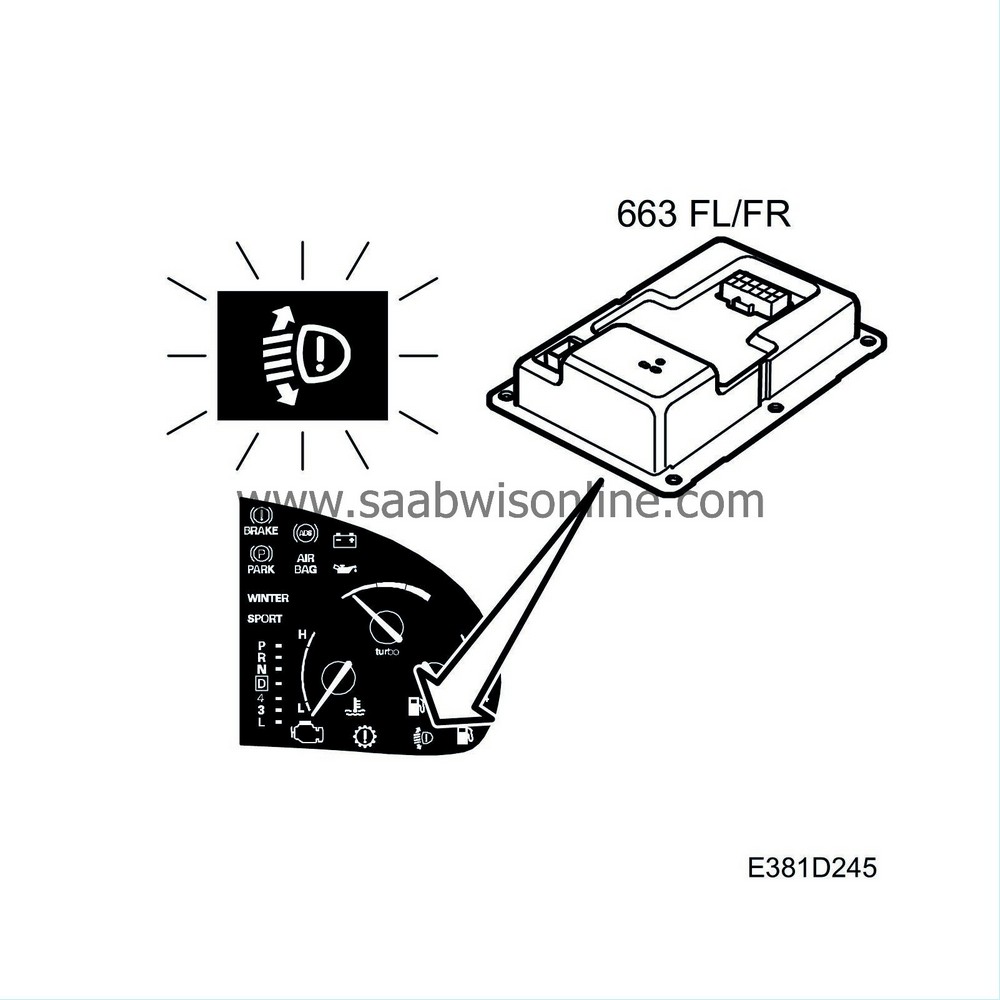
The indicator lamp warns the driver of a fault in the xenon lighting and automatic headlamp adjustment system.
The lamp is powered from the main instrument unit and grounded by the AHL control module on a system fault.
Diagnostics
The function has its own diagnostics in the sending system.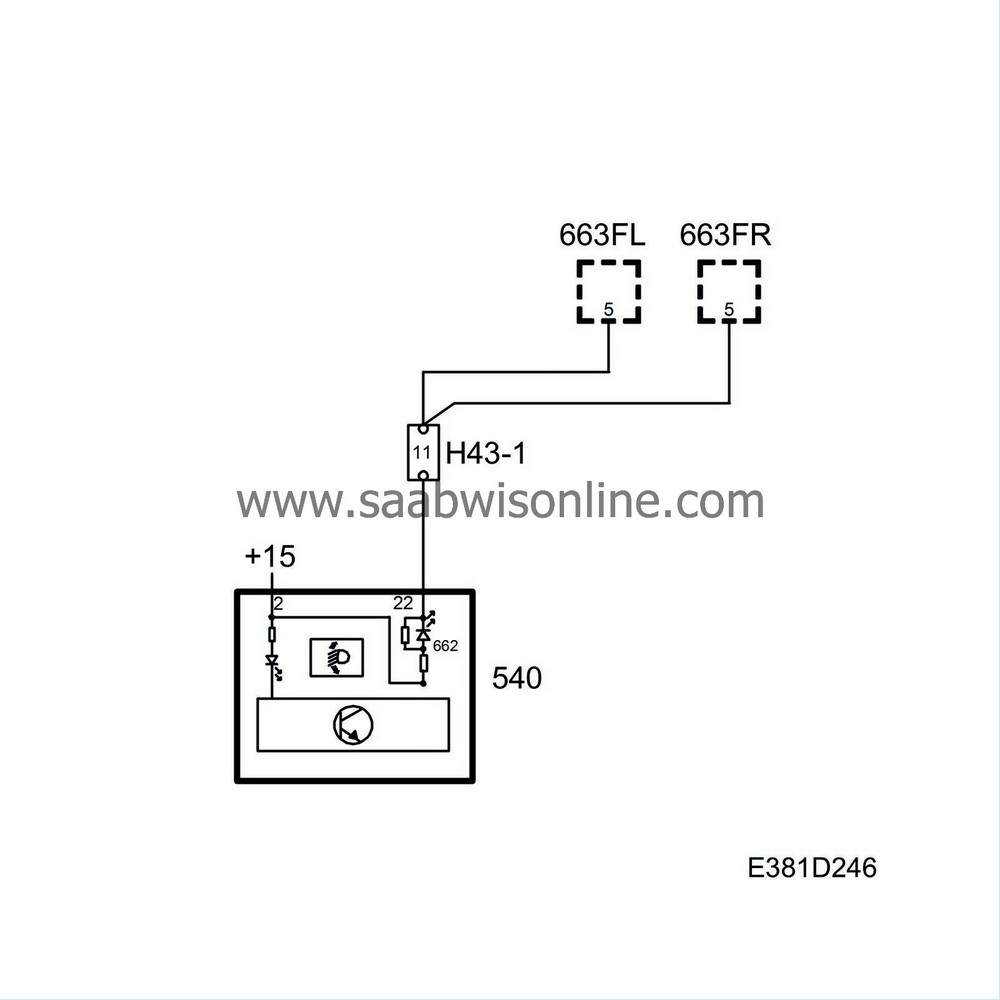
| Selector lever position indicator |
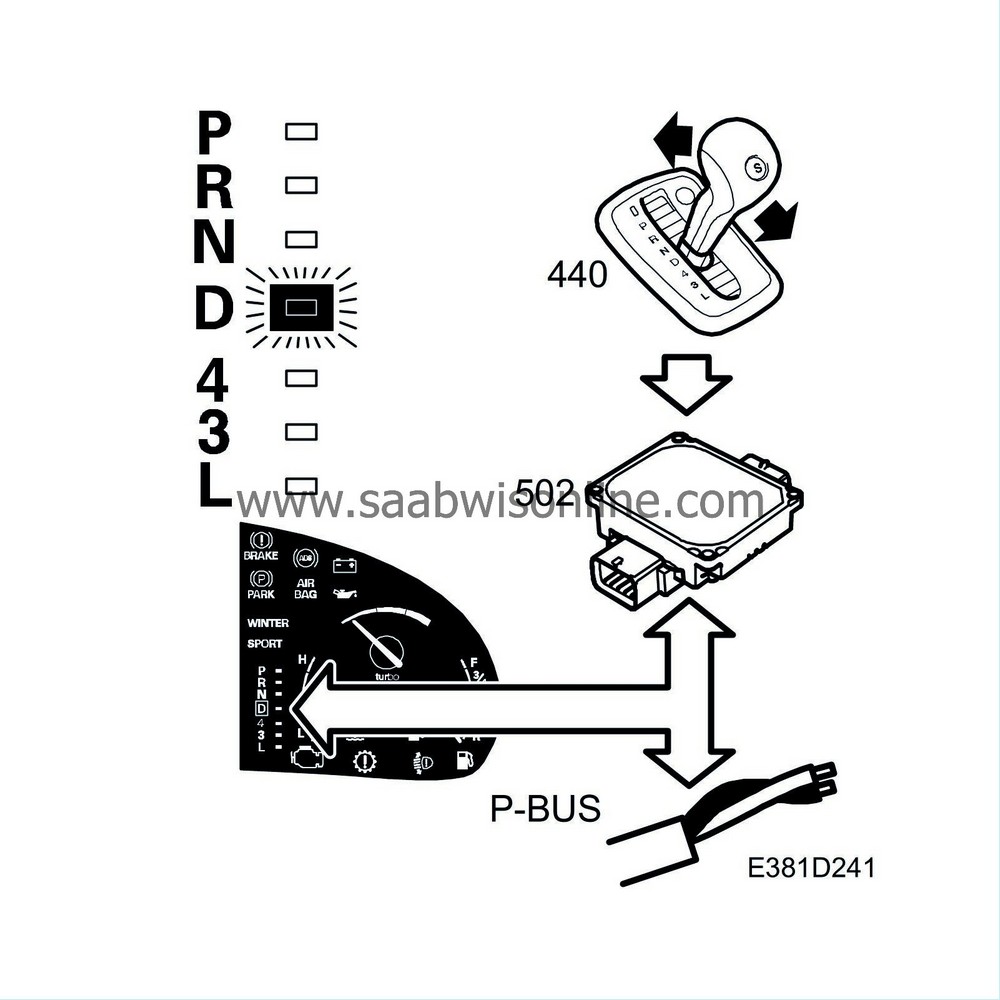
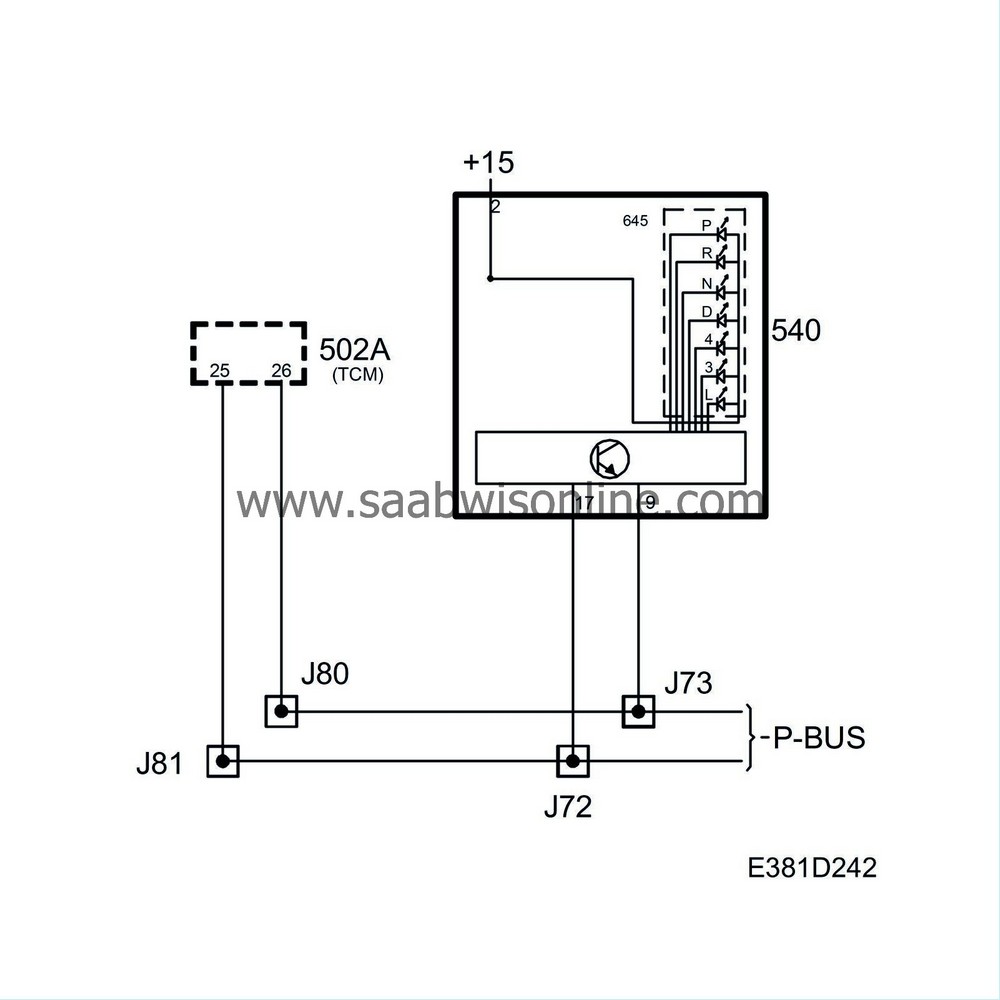
On cars with automatic transmission, the selector lever position indicator shows which gear is selected by lighting up the corresponding gear symbol.
The selector lever indicator consists of 7 segments each with an LED next to the symbol concerned (PRND43L). The symbols are illuminated by other LEDs, where the light intensity is controlled by the rheostat level.
The LEDS are powered from the main instrument unit and grounded internally by the main instrument unit. TCM continuously sends bus information on the status of all selector lever positions, unit ON/OFF.
| Example |
When the selector lever is in position P, the following information is sent:
|
Selector lever position
|
P
|
ON
|
|
Selector lever position
|
R
|
OFF
|
|
Selector lever position
|
N
|
OFF
|
|
Selector lever position
|
D
|
OFF
|
|
Selector lever position
|
4
|
OFF
|
|
Selector lever position
|
3
|
OFF
|
|
Selector lever position
|
L
|
OFF
|
The main instrument unit control module grounds the output of the LED for symbol P, which then lights up. The other symbols remain off. If another selector lever position is engaged, the status of the bus information will change. The previously lit symbol will go out and the symbol for the new selector lever position will light up.
Diagnostics
The function has its own diagnostics in the sending system.| Door indication |
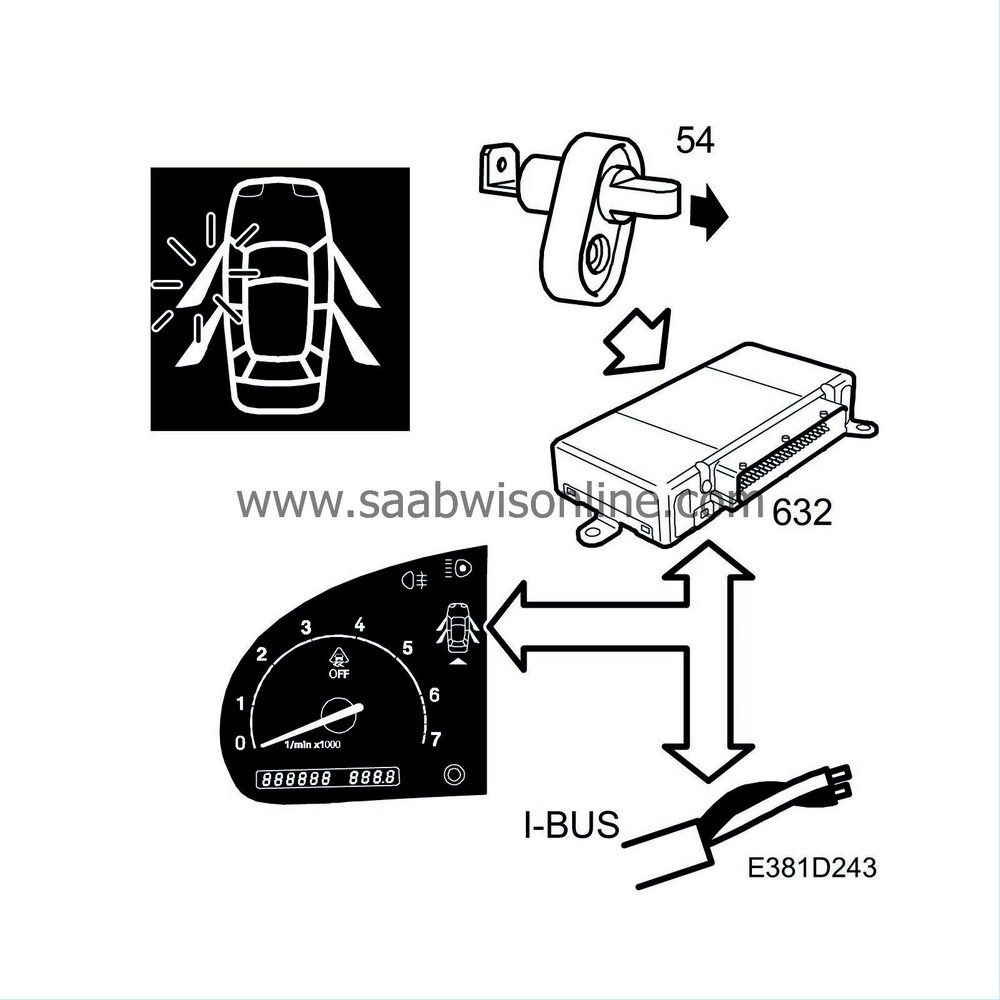
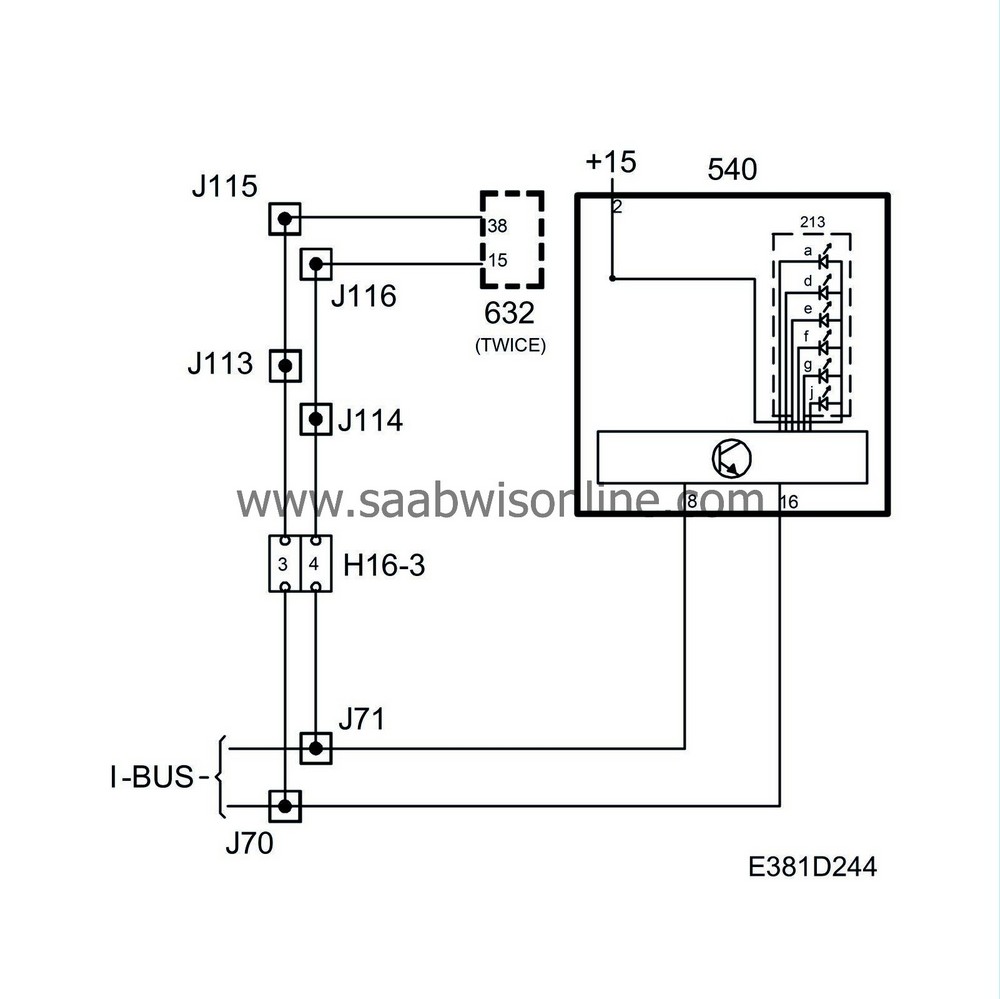
Door indication (on the pictogram) informs the driver if any of the doors or the tailgate is open. It consists of five red LEDs and a lamp. The doors and the tailgate each have an LED. The car is indicated in orange by a lamp.
The LEDS are powered from the main instrument unit and grounded internally by the main instrument unit.
TWICE continuously sends bus information on the status of the doors and tailgate, unit OPEN/CLOSED.
Example
When the driver's door is open and the other doors and tailgate are closed, the following information is sent:
|
Driver's door
|
Open
|
|
|
Passenger's door
|
Closed
|
|
|
Rear door LH
|
Closed
|
|
|
Rear door RH
|
Closed
|
|
|
Tailgate
|
Closed
|
The main instrument unit control module grounds the outputs of the symbols for the driver's door and the car, which then light up. The other LEDs remain off. The car symbol always lights up if a door or the tailgate is open.

